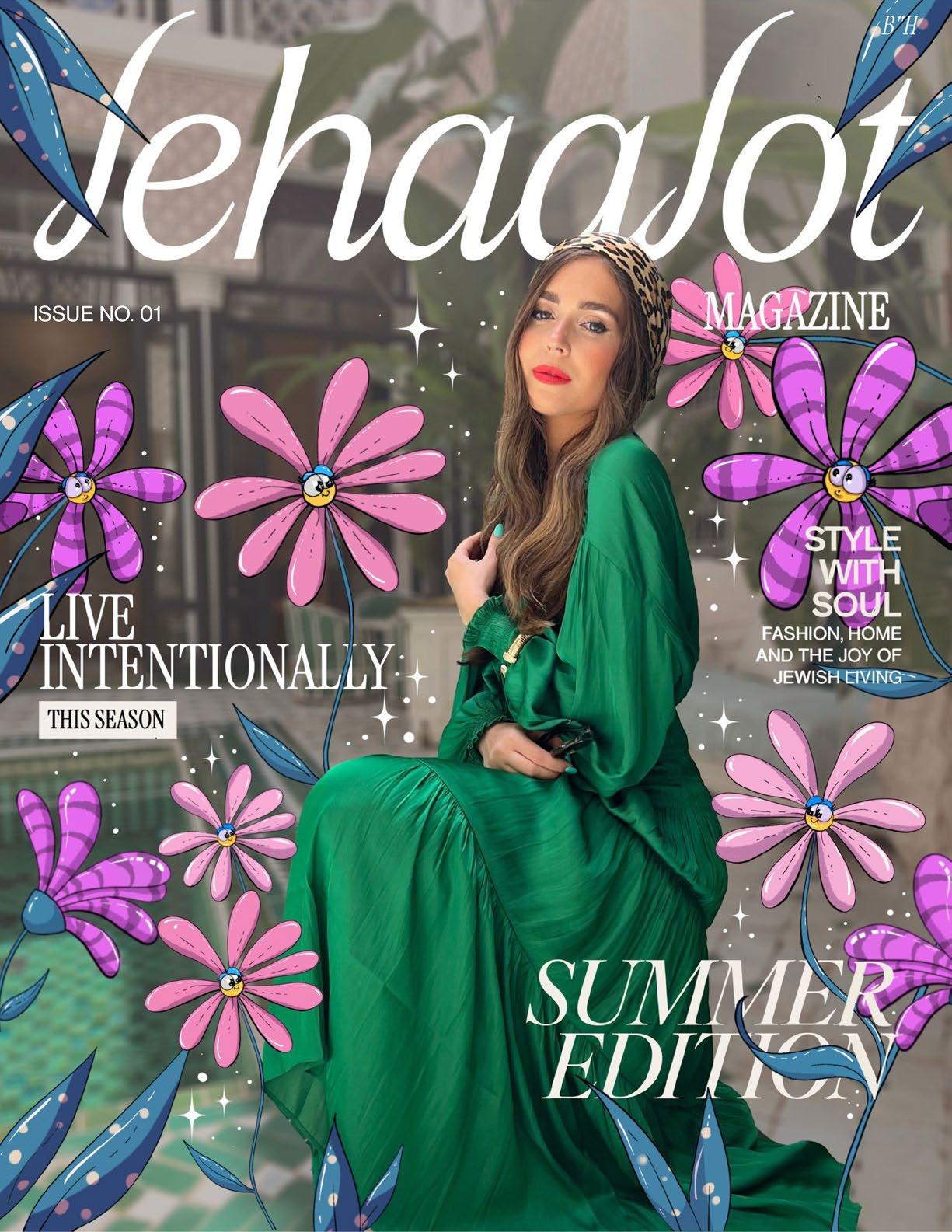
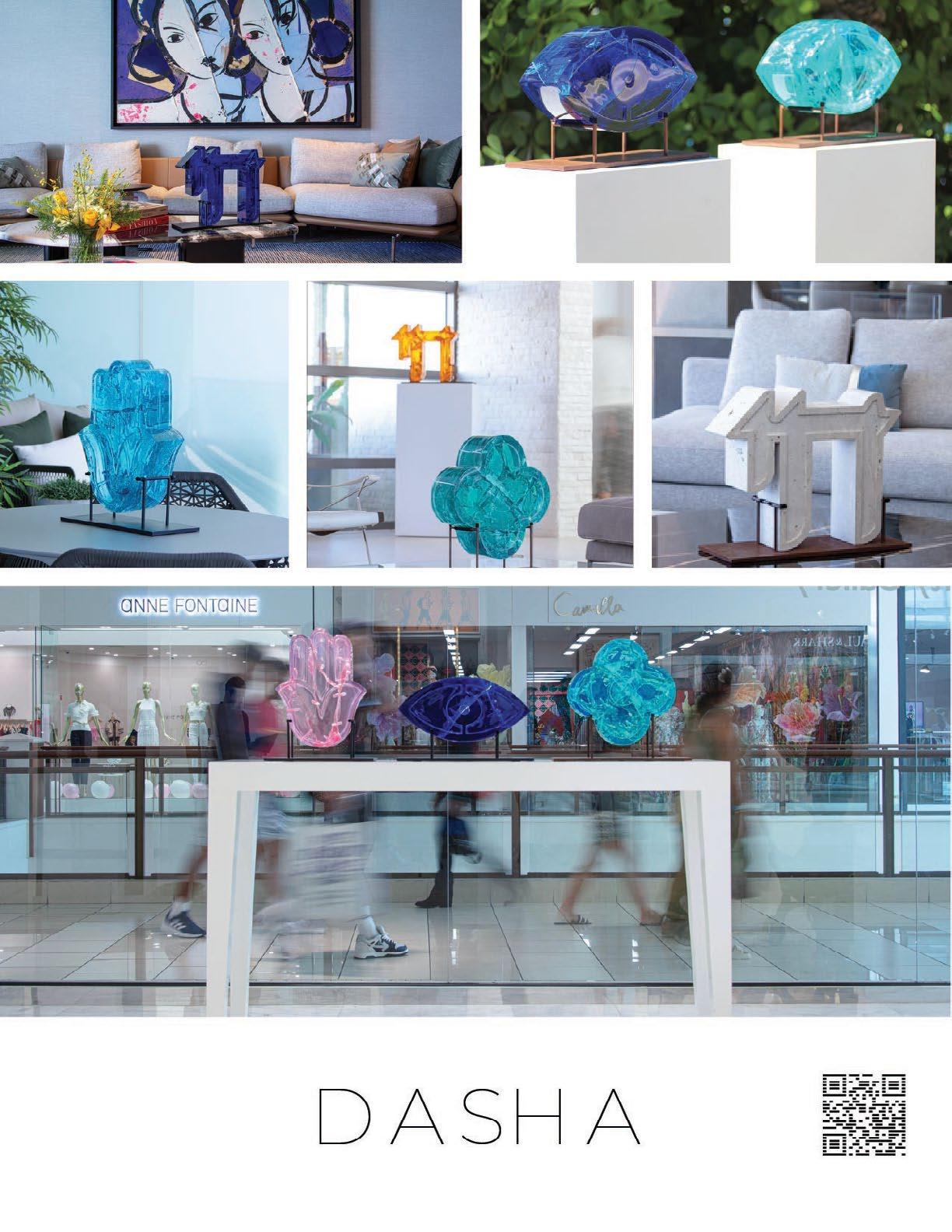
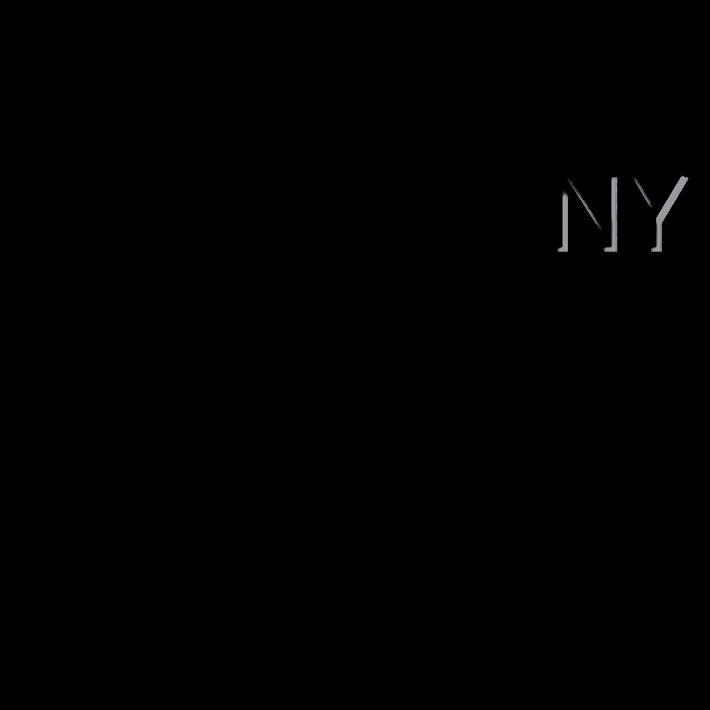
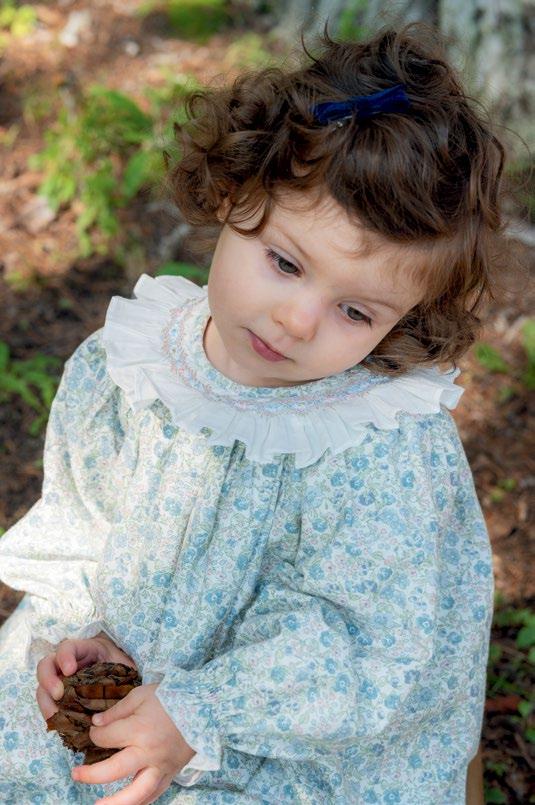
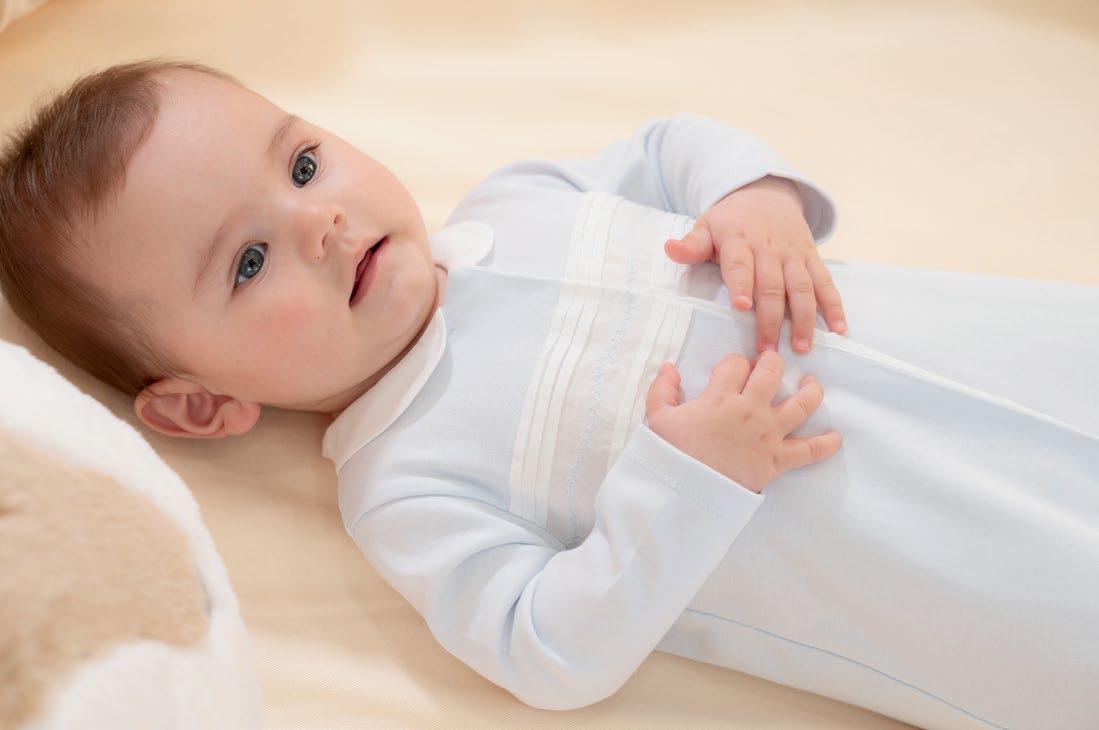
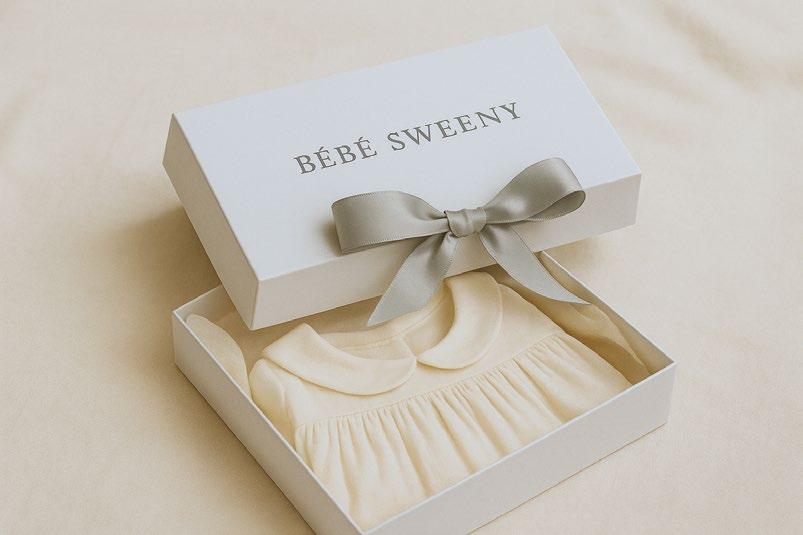








Editor’s Note by Esther Sitbon
INSPIRATION AND SPIRITUALITY
Welcome to Camp Sol: A summer for the Soul by Yaffa Palti
INSPIRATION AND SPIRITUALITY
Lizzy Savetsky: Tiny & Mighty Interview by Esther Sitbon
STYLE & BEAUTY
The Latest (And First) Fashion Statement By Mushky Lieberman
STYLE & BEAUTY
Rivka Abitbol
STYLE & BEAUTY
Charlotte Malka: Beauty, Faith and Resilience Interview by Esther Sitbon
STYLE & BEAUTY
Rewriting the rules in a Swimsuit
An interview with CVRGE founder, Jennifer Sharbani
STYLE & BEAUTY
Radiant in th Heat By Patty Zrihen Makeup Artist P.6 P.8 P.38 P.12 P.18 P.22 P.26 P.30 P.34
INSPIRATION AND SPIRITUALITY
The Allure By Deborah Malka

INSPIRATION AND SPIRITUALITY
From the Ashram to Hebron By Barbara Wolf
HEALTH & WELL-BEING
The Sacred Surrender of Sleep By Esther Sitbon
HEALTH & WELL-BEING
Why Sleep Helps you Lose Weight? By Mercedes Benavidas
HEALTH & WELL-BEING
The Power of Prevention By Sarah Rosanel
CULINARY CORNER
Nourishing the Body, Awakening the Soul
By Esther Sitbon
CULINARY CORNER
Vera Newman
By Vera Newman
CULINARY CORNER
The Story of The First Kosher Chocolatier
By Evelyne Uzan
PARENTING
How to Cultivate a Positive Atmosphere at Home? By Joy Galam
ART & CREATIVITY
Climbing My own Ladder Interview by Esther Sitbon
HOME & LIFESTYLE
The Art of Hosting, Reinvented By Maison Maizon
SOUL SEASON
A Soulful Lens on Life’s Questions By Sarah
INSPIRATION AND SPIRITUALITY
Being a Mom and a Jewish Leader Interview by Esther Sitbon
INSPIRATION AND SPIRITUALITY
A Life Commited to Making an Impact By Esther Sterental
INSPIRATION AND SPIRITUALITY
From the Ashes, a Flame Interview by Esther Sitbon

It’s hard to describe the feeling of holding this first edition of Lehaalot Magazine in my hands. There is something both humbling and overwhelming about it. This magazine is not just a new project—it’s a milestone. A moment. A beginning.
And more than anything, it’s a testimony to something I deeply believe: when Jewish women come together with heart, faith, and intention, we can create light that reaches far beyond what we imagined.
Let me be clear—this magazine is not the result of careful planning or long-term strategy. It wasn’t drafted on a vision board or drawn up in a business plan. Lehaalot Magazine was not born out of ambition. It was born out of necessity. Out of longing. And above all, out of a beautiful, undeniable chain of hashgacha pratit—Divine Providence.
Every person who is part of this magazine’s journey was placed there by Hashem. The conversations that sparked the idea, the women who showed up with their stories, their talents, their voices—none of it was orchestrated by me. I often felt I was simply holding a vessel Hashem had filled with the right people and the right timing. My role—and the role of those around me—was to say yes. To take that spark and give it shape. To choose to believe in it and build it, together.
Lehaalot means “to elevate.” It’s a word we say often, in many contexts—when lighting the menorah (lehaalot ner tamid), when offering a korban (leha’alot korban), or even in the name of a parasha (Behaalotekha). But the essence of this word holds something deeper: not just to rise, but to raise something or someone else. To help it become what it was meant to be.
That’s what we hope to do with this magazine.
To raise ideas.
To raise awareness.
To raise the spirit of Jewish women.
And through that, to help raise the soul of Am Yisrael. Since October 7th, I have heard the same words repeated in countless voices, across different countries and generations: “I can no longer live disconnected.
Something broke open in our collective consciousness. The illusion that we could live on the sidelines of Jewish life—culturally involved but spiritually distant— shattered. The attack on our people was not just physical. It was existential. It reminded us of who we are. And that we don’t get to choose when we’re Jewish. We are always Jewish. In every setting, in every moment, whether we are prepared or not. But here is the most powerful part: women didn’t just wake up—they rose.
From all corners of the world, Jewish women began looking for ways to anchor themselves more deeply. To reconnect to Torah. To deepen their tefilah. To ask bigger questions. To find each other. To find Hashem. And not in theory—in real, tangible ways. In the way we speak, the way we live, the way we carry ourselves in the world.
This magazine was born from that spirit. It is not about looking polished or pretending to have all the answers. It’s about showing up with honesty. It’s about exploring what it really means to live as a Jewish woman today—and doing so with dignity, curiosity, and strength.
Inside these pages, you will find stories that move you. Interviews that inspire you. Torah insights that invite you to reflect. Perspectives on motherhood, beauty, wellness, identity, and faith. But more than anything, I hope you find yourself in these pages. A mirror of the questions you’ve asked in your own heart. A spark of the light you carry within.
And we did. With heart. With emunah. With joy. This is the result.
Lehaalot Magazine is a community project in every sense of the word. It was created by Jewish women who care deeply—not just about themselves, but about each other, and about the future of Am Yisrael. Every contributor, every editor, every translator and designer brought her unique talents with generosity and passion. And none of this would exist without that
shared vision: that we can elevate the world by elevating one Jewish woman at a time.
We’re not here to entertain. We’re here to empower.
We believe that the spiritual and emotional strength of our people depends on the inner light of its women. That the more a woman is connected to her essence, to her source, to her mission, the more she can illuminate everything around her—her home, her children, her friendships, her work, and beyond. And we believe that light doesn’t come from the outside. It comes from within.
This magazine isn’t here to tell you who to be. It’s here to support you as you discover who you already are.
In a world that often defines women by superficial measures, Lehaalot wants to offer something deeper. A place where the Jewish woman is not reduced—but revealed. Where her voice is not filtered—but amplified. Where her story is not hidden—but honored.
You’ll read about Jewish mothers who lead with softness and strength. Artists who weave their emunah into their work. Professionals who find meaning in the everyday. Activists who turn pain into purpose. And teachers who remind us that the Torah was given first to the women—not as a footnote, but as the foundation.
And that’s what we are trying to rebuild now—the foundation.
In this time of rebuilding, healing, and redirection, we need spaces that reflect who we are and what we are striving for. We need to celebrate our victories and hold space for our vulnerability. We need to ask better questions and give each other honest answers. We need to make room for joy and beauty alongside truth and depth.Lehaalot Magazine is here to be that space.I want to take a moment to thank every woman who contributed to this first edition. Some of you wrote from the depths of your story. Others translated, designed, edited, or supported quietly behind the scenes. Every single role mattered. Every voice added a note to the harmony. And it is my sincere hope that you feel your voice reflected here.
I also want to thank every reader—whether this is your first time engaging with Lehaalot or you’ve been part of our community from the start. You are not just an observer. You are part of this journey. Your presence, your growth, and your connection are what this is all about.

To our readers in Miami, Paris, Jerusalem, Buenos Aires, New York, and beyond: we see you. We hear you. And we created this for you.
I thank Hashem above all. For the opportunity. For the clarity. For the help along the way. For giving me, and us, this mission—and the people to fulfill it with. May we continue to be worthy vessels of His light, in whatever form He asks us to carry it.
This is only the beginning. We have so much more to build together. Future editions will grow, evolve, and deepen. But I will always remember this first one as a moment of unity, faith, and courageous beginnings.
Thank you for holding it in your hands. Thank you for letting it into your heart. And thank you for being part of something that matters.
Whether through Torah, art, wellness, motherhood, beauty, or community, each contribution in this issue is a step on the journey of answering those questions—with joy, depth, and truth. Our goal is not only to inspire but to remind each of us that we are part of something larger, meaningful, and eternal.
May these pages uplift you, guide you, and remind you that your inner light is needed now more than ever.
With love, faith, and deep gratitude,
By: Yaffa Palti
Iremember one summer when everything looked bright on the outside. I was checking the right boxes—listening to inspiring classes while folding laundry, journaling in the mornings, throwing around words like “alignment” and “intention” like I knew what they meant.
But somewhere in the middle of all that light, I started feeling… off. Not in a dramatic, fall-apart way. Just this low-grade sense of burnout. Like I was doing all the right things but missing something essential. Like I was standing in the sun too long, and instead of glowing—I was just
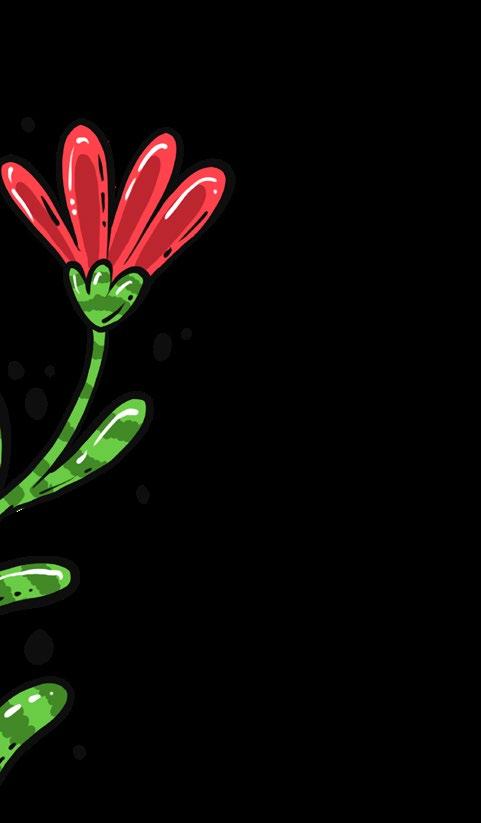
It took me a while to figure it out, but here’s
That summer, I realized I didn’t need a new shiur series—I needed a spiritual reset. A place to just be. To remember who I am without all the striving. If I could’ve checked into a place like that, it wouldn’t have been a retreat or a spa or even a fancy Rosh Chodesh event with lavender tablecloths and mini lemonades. No, no. It would’ve been… Camp.
But not the kind with tie-dye and Kool-aid (although I wouldn’t say no to a friendship bracelet). I’m talking about a place where your soul gets to run barefoot again. Where you don’t have to be impressive or productive. Where you remember how to laugh with Hashem, cry if you need to, and play a little with your purpose. A place where you don’t just tan your body—you tan your soul.
"Being spiritually sunburned doesn’t mean you’re doing something wrong. It means you’re doing a lot of things right… but maybe from the wrong place."
It’s when the light you’re soaking in—Torah, growth, inspiration—starts to feel like pressure instead of joy. When the inner work becomes performative. When you’re saying the right things but not really feeling them. When you’re
That’s spiritual sunburn. It’s overexposure to light without sufficient protection and grounding. It’s what happens when we chase doing over being. When we forget that we’re not just meant to shine—we’re meant to absorb. Integrate. Let the light nourish us, not overwhelm us.
I call it Camp Sol. Sol, like the sun—and a gentle nod to the soul.
And like any good camp, Camp Sol has its own culture. There are electives (meditation, forgiveness, napping), a zipline into your deeper self, and a camp nurse who gives out hugs and tea when spiritual growing pains hit. We roast existential questions over the fire and tie friendship bracelets with our inner child. There’s a camp song too, but it’s mostly just us humming Esa Einai while staring into the trees and wondering why no one warned us that

healing would involve this many tissues.
But Camp Sol isn’t just a fantasy—it’s a metaphor for what the summer season actually asks of us.
Because here’s the thing about the sun:
It can be healing, or it can burn. And spiritual light is no different.
Sometimes, we’re not in darkness—we’re just blinded by too much light. Too many responsibilities. Too many expectations. Too much input, too many voices, too much pressure to be “on.” Sometimes, spiritual burnout doesn’t come from a lack of connection—it comes from trying so hard to shine that we forget how to just be.
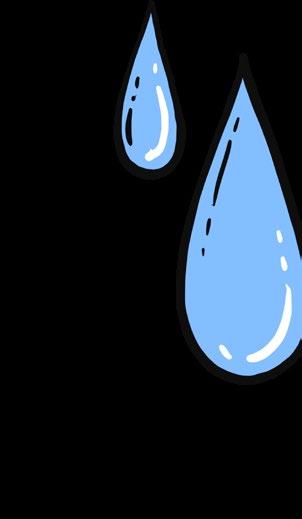
That’s what I call being spiritually sunburned. When you’ve been soaking up so much inspiration, so much learning, so much growth, that your soul feels a little… crispy. You’re saying all the right words, doing all the right things, but somewhere in there, the joy got dehydrated. And that’s when we need Camp Sol most. A place—not physical, but internal—where we soften back into ourselves.
Where we remember that we’re not just here to achieve holiness—we’re here to receive it. Gently. Quietly. Like morning sun on closed eyes.
Everything in life can start to feel repetitive, like we’re just running through motions. And then—enter Shlomo HaMelech, dropping truth bombs in Kohelet:
“Ain chadash tachas hashemesh” “There’s nothing new under the sun.”
If you’re living life by the rules of nature, that’s true. But maybe—just maybe—we weren’t meant to live under the sun.
Maybe we were meant to rise above it. When you’re ready to let go of the surface level, to rise beyond the limits of this world, newness is possible.
That’s where the true spiritual growth happens—not in constantly chasing the next shining thing, but in shifting our focus.
From the relentless demands of summer’s heat to the coolness of stepping outside that cycle, where we can see things more clearly.

replaced with cheesecake and the counselors are a few million Jewish people. Shavuot reminds us: you’re not just here to make it through the summer. You were given the Torah. A mission. A purpose. You were made for more.
We begin the summer on a spiritual high—literally. Mount Sinai. The Torah. Dairy overload. We’re glowing. Inspired. Ready to take on the world.
But like any good camp opening day, the adrenaline wears off quickly. The bunk beds squeak, the bug bites start, and suddenly, we’re in it.
(a real DIY fail)
The crash comes quick. Tammuz brings the reminder that even after Revelation, we’re still human. We fall. We forget. We worship glittery golden things.
This is the heat of challenge. The blinding kind of light that leaves us spiritually squinting. We thought we were walking in clarity, and then boom—doubt, disconnection, and a deep sunburn on the soul.
What does it mean to feel spiritually sunburned? It’s when your efforts toward inspiration leave you
feeling raw instead of radiant. It’s when the very light you’re chasing ends up overwhelming you. And it hurts, because you care. You’re trying. But
Then we head into the heat of summer. And here’s where things get real. Because the sun—like the soul—has a dual nature. It can illuminate… or it can
Sometimes we think we’re in darkness, but really we’re just blinded by abundance. There’s so much light, we stop noticing it. We live in a generation that has more access to goodness, beauty, and blessing than any in history—and somehow, we still feel like something’s missing. Sometimes, spiritual confusion doesn’t come from a lack of blessing, but from not knowing how to absorb the blessings we already have.
Let’s talk about challenge. Rupture. Chet ha’egel. The Three Weeks. It’s the summer storm in the middle of camp. The part where your bunkmate takes your shampoo, someone loses the team flag, and a bear comes into your bunkhouse.
But this part of the summer is crucial. Because it teaches us how to rebuild. How to cry for what’s broken—and still believe in what’s possible. The greatest spiritual strengths often come disguised as weaknesses. And the greatest growth? Usually found in the middle of the mess.
This is the part where we show up. Not with ego, but with humility. The kind that says: I’m not the Source—but I’m a vessel. The moment we start thinking we’re the whole show—or, on the flip side, that we’re not worthy of being seen—we’ve missed the point. We’re not here to be impressive. We’re here to be of service. Use your gifts. They’re not for you. They’re from Hashem, and they’re for the world.
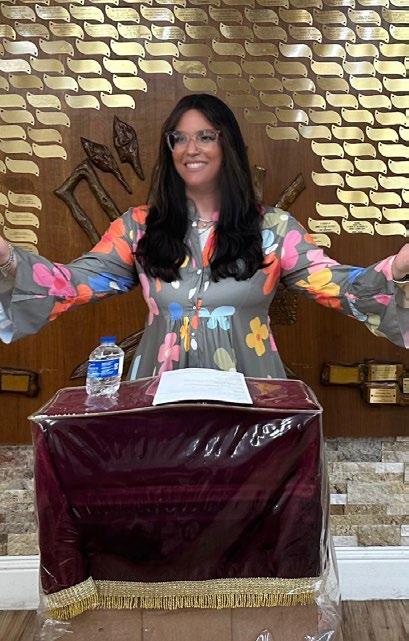
Cry Night in the Bunk — Tisha B’Av
Some nights at camp, everyone cries. You huddle in your bunk, wrapped in a sweatshirt that smells like longing, and read Eicha by flashlight. Tisha B’Av is a heartbreak you didn’t know you were carrying. But even here, there’s a strange kind of warmth. Because sometimes the tears are what water the soil for what comes next.
“There’s nothing new under the sun.”
Maybe we weren’t meant to live under it. Maybe we were meant to rise above it. Maybe when we’re ready to rise beyond the limits of this world, that’s when miracles await us.
Because even in our brokenness, there’s wholeness. Even in the ashes, there’s always a spark.

Just when you think summer is all sweat and sorrow, surprise! Tu B’Av shows up like a dance party in the woods. Love enters the campgrounds. Not just romantic love, but the kind that reminds you: your story isn’t over. Renewal is always an option. Sometimes the deepest healing begins in the dark.
There’s a plot twist. A new light. This is the day of unexpected joy, of soul connections, of remembering that the most important relationship you’ll ever have is with… your soul.
Because sometimes your soulmate is your soul.
And in that moment, you realize: this journey isn’t about reinventing yourself. It’s about returning to yourself. To who you already are beneath the sunburn, beyond the noise.
Camp’s almost over. The air shifts. Things get quieter. We start to think about who we want to be when we get home.
You pack your bags. You write soul-notes to your bunkmates (aka your inner child, your higher self, and maybe your yetzer hara). You’re not the same person who arrived on Day One. You’ve cried, grown, laughed, stumbled. You’ve realized that you’re not here to be impressive—you’re here to be a vessel. To let Hashem move through you.
Elul doesn’t demand perfection. It invites presence. Return. Reflection. Compassion.
You don’t have to go big. You just have to go inward.
The cabins may close, but the journey doesn’t end. We live in a world of limits, but who you are is unlimited.
So go ahead. Step out into the sun. Just don’t forget your soul-block.

A conversation on faith, struggle, and the sacred spark
Whether in a heartfelt post or in a powerful video, Lizzy Savetsky’s presence carries truth, strength, and heart. To me, as I once told her before Purim, she embodies something rare and precious—a modern Queen Esther, bold in her mission, faithful in her values, and deeply devoted to Am Yisrael. As I sat down with her for our very first podcast episode, I hoped to create a space not only to honor the activist she has become, but to meet the woman behind The Voice. What unfolded was a tapestry of vulnerability, inspiration, and deeprooted spirituality—a journey not just of a public figure, but of a soul seeking light and sharing it generously.
Esther Sitbon: Lizzy, thank you for being here. I’d love to begin with a question rooted in storytelling. If your life were a book, what would its title be and why?
Lizzy Savetsky: I think it would be Tiny and Mighty. I’ve always been very little physically—the smallest in my class—but I had big dreams, big feelings, everything about me felt so much bigger than my body. I never questioned whether I could do something; I just went for it. I think about the Jewish people the same way—we’re small but mighty, and so is our beloved Israel. Being


small isn’t a limitation—it’s a source of power and purpose.
Esther Sitbon: You grew up in Fort Worth, Texas. That’s not a place many associate with Jewish identity. How did that environment shape you?
Lizzy Savetsky: It shaped everything. Fort Worth had very few Jews, and even fewer who were observant. So if you wanted a Jewish identity, you had to build it yourself. My parents gave me a foundation—this deep awareness of what it means to be Jewish and the responsibility that comes with it. I always felt like I had to be a spokesperson for the Jewish people, even as a child. And somehow, that responsibility planted the seeds for everything I do today.
Esther Sitbon: That must have been challenging. Did you feel pressure being seen as “the Jewish girl” among your peers?
Lizzy Savetsky: Definitely. I grew up in the Bible Belt, surrounded by well-meaning friends who didn’t really understand what being Jewish meant. I had to explain my holidays, why I didn’t go to school on Rosh Hashanah, why we lit candles on Friday nights. It forced me to understand myself better. My connection to Judaism wasn’t spiritual at that time—it was cultural, rooted in family stories and legacy. But it laid the groundwork for the spiritual journey that would come later.
Esther Sitbon: Your family’s history is so powerful. Where are your roots originally from?
Lizzy Savetsky: I’m Ashkenazi. My greatgrandfather was from Tikotyn, Poland—a village that was completely destroyed during the Holocaust. Another branch of the family suffered terribly in pogroms in Ukraine. My great-greatgrandfather lost an eye before escaping to America. Growing up, I carried those stories with me. They made me realize just how much was sacrificed so that I could live a life of freedom— and that freedom comes with a responsibility to honor their memory. That’s such a powerful inheritance. And yet, you also had this very American, Texan

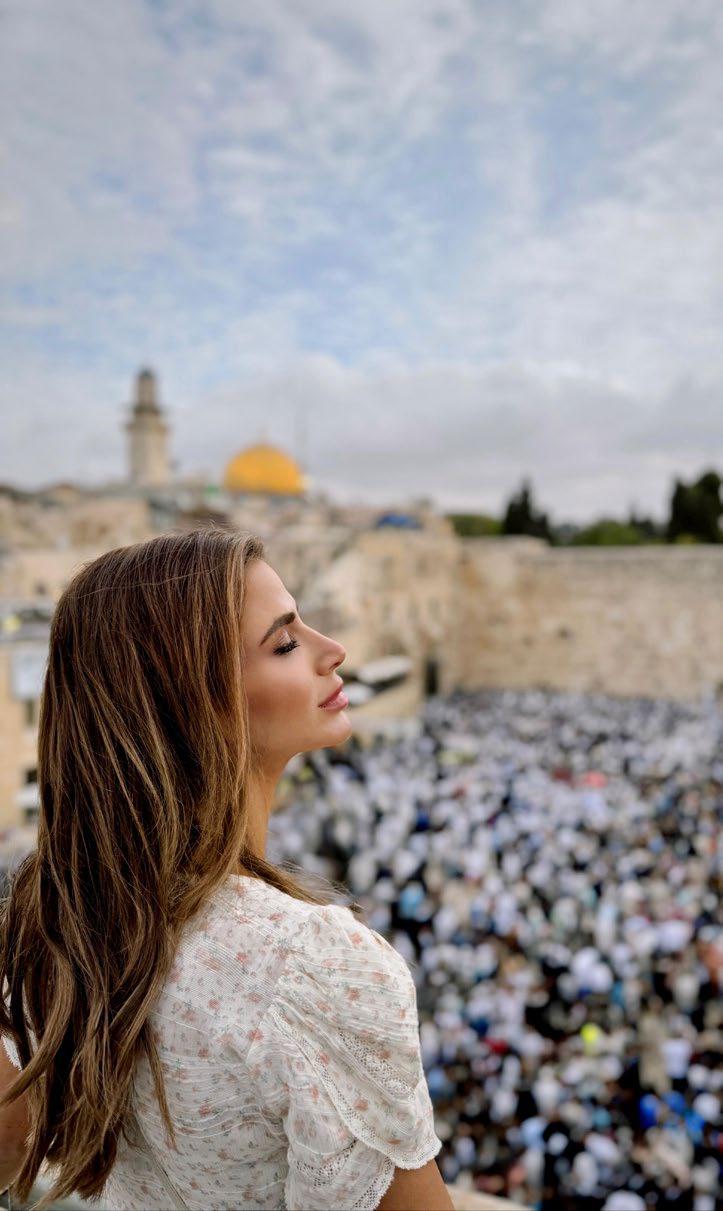
"Our mission is to elevate the physical—to bring holiness into every corner of our lives."
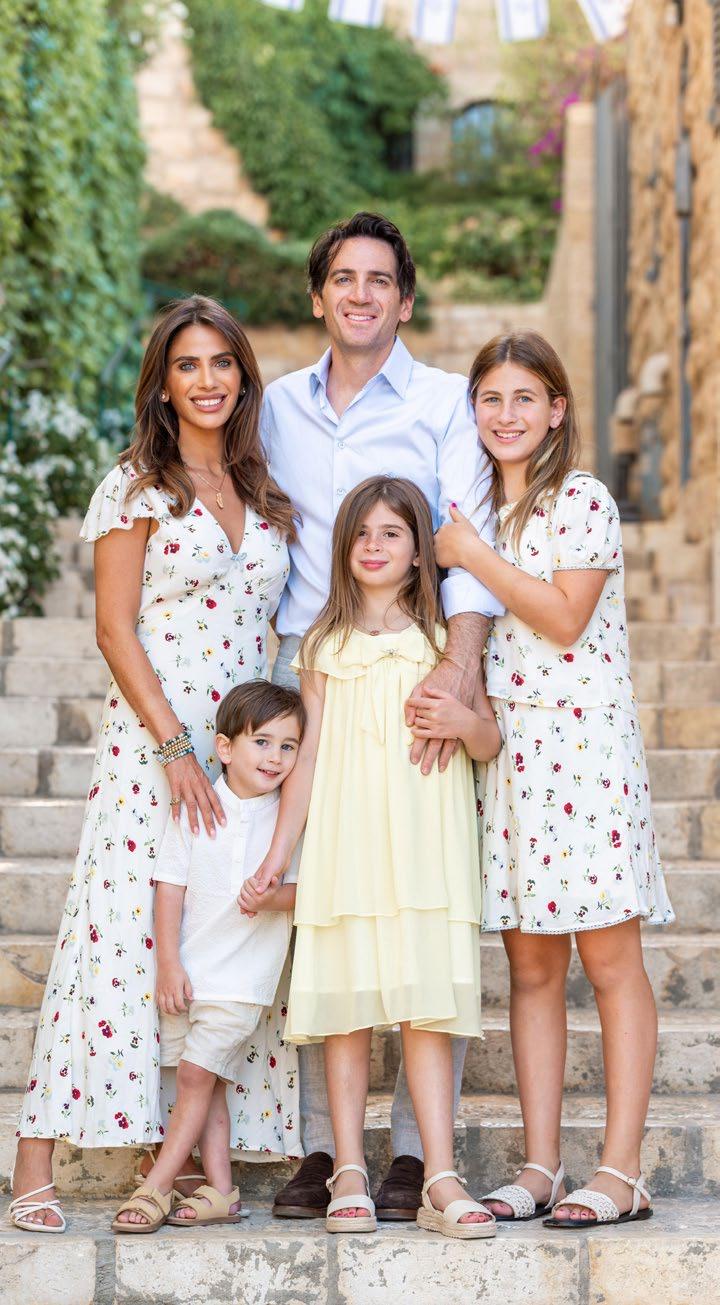
Esther Sitbon: That’s such a powerful inheritance. And yet, you also had this very American, Texan childhood—cheerleading, country music, pageants. How did you navigate both worlds?
Lizzy Savetsky: I needed both. They were both authentically me. I loved the performance, the sparkle, the pageantry. But I also had this deep, emotional, soulful side nurtured by my family’s stories and traditions. And I still feel like I live in both those worlds today. I believe that Judaism doesn’t separate the spiritual from the physical. Our mission is to elevate the physical—to bring holiness into every corner of our lives.
Esther Sitbon: That’s beautifully said. And I know music has been such a part of your life. Did you study it formally?
Lizzy Savetsky: I did. Music was always my outlet. I studied it seriously. And as I started to take steps into observant life, I had to ask myself: How do I elevate this gift? How do I use it in service of something greater than myself? That’s a question I still ask.
Esther Sitbon: You mentioned earlier the concept of planting, and how brokenness can be the start of growth. Can you share a moment in your life that felt like that—a moment of breaking that led to blossoming?


It’s time to join The Mazel Club...

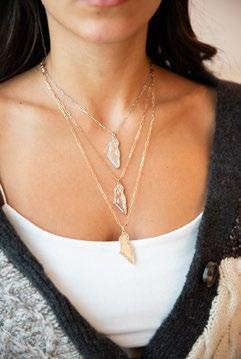




“World renowned celebrity fine jeweler, original designer of the iconic Mazel Ring and Mazel Collection with a percentage of every sale donated to Jewish causes.”



Lizzy Savetsky: Absolutely. The hardest thing I’ve ever been through—my deepest struggle and my greatest treasure—was getting sober. I’ve lost pregnancies, I’ve dealt with self-esteem issues. But the battle with addiction was the most transformative. I always had this deep loneliness, even as someone who seems outgoing. Alcohol became a way to shut down the noise in my head. I wasn’t partying—I was isolating. And eventually, I realized I couldn’t keep going like that. I was living a lie.
Esther Sitbon: What gave you the strength to change?
Lizzy Savetsky: I hit a point where the pain was greater than the fear. I was standing on a friend’s basketball court in Dallas, and I just started talking to God. Out loud. I told Him I was done trying to control everything. That I couldn’t do it anymore. That moment was the beginning of everything. I

went to a 12-step meeting. I started working the program. And I’ve stayed sober with God’s help every day since.
Esther Sitbon: That’s extraordinary. What did surrender mean for you spiritually?
Lizzy Savetsky: It meant finally letting God take the lead. Even though I was already observant, I didn’t really trust. I was terrified—of losing control, of facing myself. But the truth is, sobriety is impossible without spiritual connection. Now, my conscious contact with God is the anchor of my life. Without sobriety, I have nothing. Not my family, not my voice, not my mission.
Esther Sitbon: You’ve been so open in sharing this. What moved you to do that?

Lizzy Savetsky: At first I was afraid—ashamed, really. But I realized that so many women are struggling quietly. If my story can give even one person the courage to ask for help or reconnect with God, then I’ve done something meaningful. Sobriety taught me that brokenness isn’t the end—it’s the soil for the most beautiful growth.
Esther Sitbon: You’ve become such a voice for Am Yisrael, especially since October 7. What has that been like?
Lizzy Savetsky: Painful, and holy. I never imagined I’d be thrust into this position, but I feel like everything in my life prepared me for this moment. It’s exhausting and heartbreaking. But it’s also the greatest honor. I feel like I’m standing for my ancestors, for my children, for every Jewish woman who’s ever been silenced. I ask God before every post, every speech: Please make me Your vessel.
Esther Sitbon: How do you hold both strength and softness as a woman in that role?
Lizzy Savetsky: I embrace both. I cry a lot. I feel deeply. But I also show up fiercely. I carry megaphones and wear heels. I speak out, but I also nurture my children and light my candles. The world needs both fire and tenderness. And women—Jewish women especially—carry that duality with such grace.
Esther Sitbon: Speaking of tenderness, your connection with Ira is deeply moving. How has your marriage supported your journey?
Lizzy Savetsky: Ira is my anchor. We’re very different—he’s grounded, logical. I’m emotional, passionate. But we’ve built something strong. He supported me through addiction, through loss, through my religious journey. We’ve had to grow together. It’s not easy, but it’s real. We respect each other’s process. He believes in me, even when I struggle to believe in myself. That’s love.
Esther Sitbon: And what does Shabbat look like in your home?
Lizzy Savetsky: Shabbat is my heart. Lighting candles, kissing my children—it’s everything. We may not have a Pinterest-perfect table. I’m not the classic balabusta. But we have peace, joy, connection. That’s what I want my children to remember—that Shabbat is where we come home to ourselves.
Esther Sitbon: What message would you share with Jewish women seeking to reconnect?
Lizzy Savetsky: Start small. Light a candle. Say a blessing. It doesn’t have to be perfect—it just has to be real. You are holy because you exist.
Your pain, your joy, your questions—they’re all part of your light. And that light is needed more than ever.
Esther Sitbon: Lizzie, thank you. For your bravery, for your honesty, and for your unwavering commitment to shining light in dark places. You are truly tiny and mighty.
Lizzy Savetsky: Amen. Thank you, Esther. I’m honored to share this space and this mission with you.
“I feel like I’m standing for my ancestors, for my children, for every Jewish woman who’s ever been silenced.”


Watch the full conversation here

Follow on instagram @lizzysavetsky

By: Mushky Lieberman
Afew days ago, in the postpartum days after having my eighth baby, thank God, I decided to go out for a coffee. I needed to be alone, in silence, to be able to hear my thoughts clearly. It was a hot day in Buenos Aires, and a wave of cold air welcomed me as I opened the door to the café. While I was waiting at the counter for my order to be ready, I saw through the café window two bochurim from the Yeshiva walking by, deep in conversation. So young, happy, and genuine.
They completely captured my attention, and I followed them with my gaze for a few steps. The heat outside was oppressive, and we were in a trendy neighborhood of Buenos Aires. Mothers walking their kids to school wore stylish sneakers and designer bags. Teenagers heading to the gym were in sporty outfits, and women going to work meetings wore elegant clothes—nice blouses and blazers. I truly enjoy sitting and observing the fashion around me; it entertains and inspires me. However, the moment I saw the bochurim, everything around me disappeared. A wave of admiration and tenderness swept over me. Their Hasidic clothing stood in stark contrast to the heat—heat that made even the trees sweat—and in that image, I found all the inspiration I needed.
What qualities define a woman with true style? The very same ones that emanate from these boys.
These women are authentic. They know themselves, they know their worth, they enjoy fashion while taking from it only what
suits their personality and lifestyle, and they embrace only the trends that truly represent them. They are not slaves to the latest fashion craze, nor do they blindly follow every new trend.
Don’t get me wrong—I love fashion. But what really fascinates me is when we stop being its slaves and begin to use it as a tool to express ourselves, to create, to tell the world who we are.
To celebrate our radiant and beautiful souls. When we’re able to enjoy fashion without compromising the laws of tzniut (modesty). When we wear Miu Miu-style pleated midi skirts or long bohemian dresses with cowboy boots—both current trends—we are doing exactly that: enjoying fashion while following a trend that is eternal. One that has existed since the giving of the Torah. One designed by HaShem, our Father, because He knows what’s best for us.
This trend isn’t the kind that, years later when you look back at old photos, makes you say: “What was I thinking?”
This trend brings you pride. It helps define your style because it pushes you to know yourself and your worth.
What are my values?
Where does my worth lie?
The answers to these questions are essential for being a confident and stylish woman.
And why not—a woman who enjoys fashion.



Follow on instagram @mushkylieberman



“Modesty isn’t about hiding; it’s about honoring who I am”
“For me, how I dress reflects my inner values and connection to Hashem”

y name is Rivkah Levy, I’m 34 years old, a wife and mother of four. I’m a Montreal-based fashion influencer with a Moroccan background, born and raised in Canada. I’m dedicated to promoting elegant, modest fashion. Through my platform , I aim to help women dress modestly while feeling confident and stylish.
I’ve loved fashion ever since I was little. I remember spending Shabbat afternoons with my sisters, helping them plan their outfits for the week. Later on, I started working in clothing stores, and I kept getting comments like, “If I didn’t know you were religious, I would’ve never guessed—you wear skirts in such a nice, fashionable way.” That really encouraged me to keep finding creative, stylish ways to dress modestly and inspire others to do the same.
I grew up in a religious home, and it was always clear to me that I would keep tzniut no matter what. I never felt forced to dress modestly—on the contrary, I truly felt it was empowering and gave me strength. Tzniut has helped me in so many aspects of my life; it’s protected me, grounded me, and shaped the way I see myself and the world. I wanted to show that modesty can be beautiful, elegant, and uplifting, and inspire other women to feel the same.
For me, how I dress reflects my inner values and connection to Hashem. Modesty isn’t about hiding; it’s about honoring who I am. I try to express beauty, dignity, and confidence through my style, believing that when we dress with intention, we reflect our inner light and the beauty of being a Jewish woman.
One of the biggest struggles I hear from women is finding modest bathing suits. I personally remember struggling with this myself, as there weren’t many stylish, modest options available at the time. I’ll never forget a trip to Cancun with my husband, where I decided to create my own bathing suits. It was the best decision I made, as it allowed me to feel confident and comfortable in my own skin at the beach.
My advice is to focus on lightweight, breathable fabrics and layering creatively. Maxi dresses, long skirts, and loose, flowy tops can be both comfortable and stylish while keeping you cool.
I love fabrics like cotton, linen, and silk during the summer. They keep me cool and comfortable while still offering full coverage.
Layer Lightly:
Layering doesn’t have to mean adding heat. A light cardigan or kimono is a great way to stay modest without feeling hot.

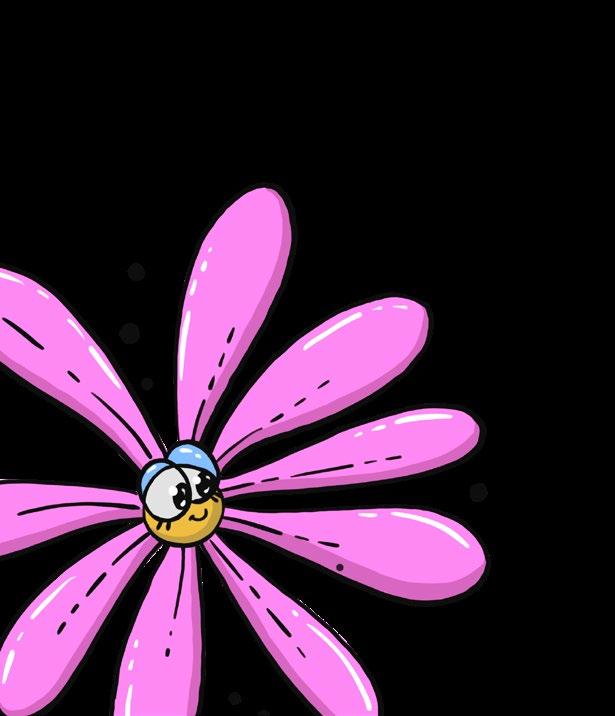


Maxi Skirts or Dresses Are Your Friend:
They’re so easy to wear, comfy, and perfect for the summer heat, while still keeping you covered and stylish.
My go-to summer look is a 3/4 length sleeve shirt paired with an embellished skirt or a lace skirt, sometimes with a dress and always topped off with some beautiful accessories. I also love wearing colors all year round, but especially in the summer—it just makes me happy and adds so much life to my wardrobe. Follow on instagram @myfashionologybyr

Set with this sweaters and the skirt from la garde robe de nina Sneakers from new balance

Charlotte Malka, widely known on social media for her sense of style, humor, and authenticity, opens up here in a much more intimate way: revealing a journey of deep faith and resilience, forged through illness and adversity. In this honest and moving interview, she reflects on years of struggle, the inner transformations they sparked, and her mission today: to share light in all its forms.
Esther Sitbon: Charlotte, welcome to Lehaalot Magazine. It’s a deep joy to welcome you here for an honest, inspiring conversation. You’re one of those women who lifts the light of others—despite challenges, or perhaps because of them. Thank you for being here with us today.
Charlotte Malka: I’m very moved to be here with you.
Esther: If your life were a book, what would its title be?
Charlotte: “Living Fully.” I’ve learned so much through the challenges about the value of life. I try to remind the people around me that every
Charlotte Malka was born into a family of fashion entrepreneurs, where style and travel were part of daily life.
She is a trained lawyer turned lifestyle entrepreneur. Based in the U.S. for the past ten years, she shares fashion tips, beauty finds, and real-life moments on her account @CharlotteLoveShopping. A strong advocate for tsniout style, she shows that modesty and elegance can absolutely go hand in hand—on any budget.
day is a chance. Small things are really big things. And when you lose them, you realize just how precious they were.
Esther: You shared so powerfully your journey with Crohn’s disease, the joint pain, and the daily challenge of living with a body in constant discomfort. Yet you radiate positivity.
Charlotte: I was diagnosed at 18. Since then, I’ve had two major surgeries and had to learn how to live with chronic pain. But I got back up. I realized that every morning I can stand and walk—it’s a miracle. I can’t always carry my children. I can’t stand or sit for long. Every position becomes a conscious effort. But that’s what taught me: when you have health, you have everything.
Esther: You also told me that even before the illness, there was an inner sadness. A feeling of not belonging.
Charlotte: I was a very sad child. I spoke to Hashem
“If this baby is going to suffer, please take him Yourself. Don’t ask me to choose.”
every night. I would ask Him why I was here. I even asked Him to take me back. But today I understand— getting sick gave me a mission. It gave me roots. It stopped me from running away from myself. I understood I was meant to live—but to live fully.
Esther: And today, you express that mission beautifully through your Instagram. There’s fashion, of course, but mostly there’s a deeply embodied way of living with emunah.
Charlotte: It started as a styling account. But soon I began speaking about faith, gratitude, little spiritual moments. Women responded. I get messages from women who started keeping Shabbat, fasting, praying—because they saw something in my story they connected to. I’m not trying to preach. I just share honestly.
Esther: One of the most powerful moments you shared was about a surprise pregnancy—and a painful loss.
Charlotte: I found out I was pregnant between two birth controls. It wasn’t planned. At first I was scared. Then I started to love this baby. One day, at the Ohel, a little boy with Down syndrome came up to me, kissed me, touched my hair, danced around me. And I just knew. I said to Hashem, “If this baby is going to suffer, please take him Yourself. Don’t ask me to choose.” A week later, the heartbeat stopped. Later, doctors confirmed it was trisomy 22, a condition incompatible with life. Hashem had listened to my prayer. He didn’t punish me—He protected me.
Esther: That story is so moving. And you speak of it with such clear, rooted faith. You remind us: nothing is too small for God.
Charlotte: I started praying for everything. Even finding a lost item. People think they’re bothering God with little things, but we’re not. He wants to be part of our lives—every little step. I talk to Hashem all the time. In the car, at the grocery store, looking for parking... It’s a constant conversation. And
now, my kids talk to Him too. That’s how natural it’s become.
Esther: That perspective also shaped your view of modesty. You recently did a special photoshoot for Lehaalot, with tzniut outfits. And you said something striking…
Charlotte: I did the shoot half for a brand, half for Lehaalot. When I saw the pictures, I liked the modest ones better. Even my face looked brighter. My husband saw it too. And I never try to look religious—I want to be aligned, not disguised. Tzniut doesn’t define me, but it dresses me from the inside out.
Esther: You build bridges, Charlotte. You allow women to connect to spirituality without pressure or posturing. You light their flame.
Charlotte: That’s what I try to do. To show that even with illness, imperfection—we can shine. Faith doesn’t pull us away from life, it anchors us deeper in it. That’s my mission: to inspire, to strengthen, to share. In my rhythm, my style, with my story.
Esther: Thank you, Charlotte, for your light, your truth, your courage. You remind us that every woman can turn the ordinary into the extraordinary. That’s what Lehaalot is all about.
Charlotte: Thank you. And bravo for what you’re doing. I hope every woman reading these words finds a spark that helps her rise.


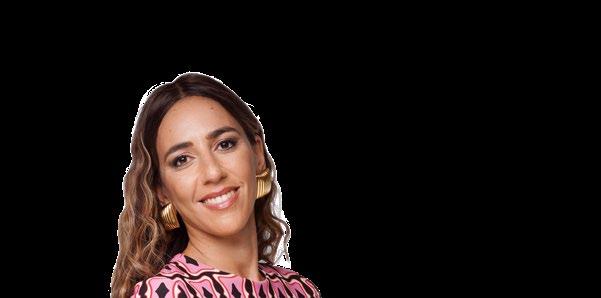
Photoshoot by Diane Levy Photography. Follow on instagram @dianelevyphotography or email info@dianelevyphoto.com

Shirt Lanalou
Skirt zimmerman
Earrings lovabyvl Shoes hermes
Dress from desigual | Tips to create a tsniout Outfit i put a White shirt inside (from Zara ) Hat from kroyn official | Shoes from Chanel | Pouch from bottega venetta

Photoshoot by Diane Levy Photography. Follow on instagram @dianelevyphotography or email info@dianelevyphoto.com
Photoshoot by Diane Levy Photography. Follow on instagram @dianelevyphotography or email info@dianelevyphoto.com

Tsniout swimwear from astaraswim (two pieces) Shoes from hermes
Wig from dini wigs
Shirt and skirt from la garde robe de Nina (Instagram only ) Earrings from lovabyvl Shoes from hermes Wig from dini wigs

Photoshoot by Diane Levy Photography. Follow on instagram @dianelevyphotography or email info@dianelevyphoto.com
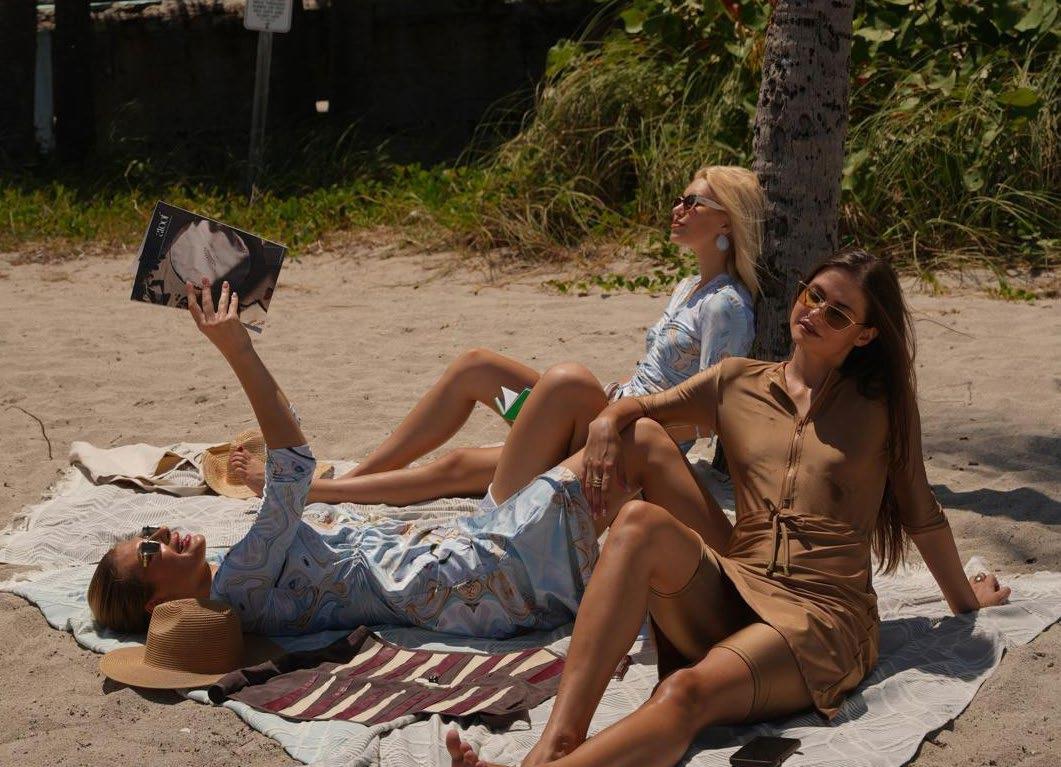
I’ve always known I was going to do something in fashion—mostly because I never really wanted to do anything else. I grew up assisting my father at Coterie when it was still held at the Plaza Hotel (yes, that Plaza—where the chandeliers are almost as well-dressed as the attendees). I was just a kid, but I already knew: the world of fashion wasn’t just exciting; it was where I belonged.
Eventually, I made it official and attended FIT to study fashion buying and merchandising. From there, I landed an entry-level job at Valentino, working in the showroom and eventually moving up through PR, sales, and other roles in the New York office. Later, I joined Chloé and worked my way up to become the wholesale sales manager for the U.S. Accessories division. It was exhilarating—and exhausting—and then I did something that doesn’t usually happen on a traditional fashion résumé: I took a long break.
That break came with a deeper journey. I was raising my children, becoming more religious, and slowly making a promise to myself: when I re-entered the world of fashion, it would be on my terms. I wanted to bring beauty, elegance, and empowerment to women—specifically, women choosing modesty. I didn’t know what that would look like yet. But I knew it had to be meaningful. It had to matter.
During Covid, I was teaching in a preschool and barely surviving Zoom school—may we never speak of that era again. And in that quiet, introspective time, something began to stir. I looked around at the modest fashion world and realized something was missing. A lot of somethings, actually. The sophistication, the style, the joy I grew up with in fashion didn’t quite translate— especially when it came to swimwear.
Now, I love Miami. But showing up to the beach in a droopy swim dress while everyone else is in sleek designer pieces was… let’s just say, humbling. I didn’t want to be them, but I also didn’t want to feel like I was disappearing. That moment hit me hard. If I—a fashion girl to the core—couldn’t find something that made me feel both modest and magnetic, surely other women were feeling the same. That’s when CVRGE was born. The mission of CVRGE is to make sure women never feel unseen. Modesty isn’t about blending in. It’s about showing up with intention, dignity, and yes—style. CVRGE is deeply rooted in our Jewish values, in the


belief that we are daughters of the King. Jewish queens. And queens should feel beautiful, whether they’re at a wedding, a weekday errand, or wading into the water with their kids.
Creating modest swimwear that feels elevated was my way of turning a fashion challenge into a fashion revolution. We’re used to seeing swimwear equated with exposure—but I wanted to flip that idea on its head. You can be covered and still captivating. In fact, I think modesty is more alluring. More confident. And when our models—many of whom usually wear bikinis—put on a CVRGE set and say, “Wow, I feel amazing in this,” I know we’re onto something real.
That doesn’t mean it’s always easy. One of the biggest challenges has been understanding the nuances of all the different Jewish communities. Modesty doesn’t look the same for everyone, and that’s actually what makes it beautiful—but also tricky from a design and marketing perspective! Still, the greatest reward is hearing from a woman who’s just starting her journey with modesty. When she tries on CVRGE for the first time and feels confident—especially if she’s surrounded by family or friends who aren’t dressing modestly—those moments make it all worth it.
If I could speak directly to women who are exploring modesty, I’d say this: make a promise to yourself to show up—every day, in every season, in every version of who you are—as your most beautiful, highest self.
Modesty
isn’t a limitation; it’s a lens. Shift your mindset. It’s not about hiding—it’s about highlighting the parts of you that truly shine.
There are so many stunning options now. Don’t settle for “meh.” You deserve magic.
As for the future? I see something bright—blinding, actually. We’re at the beginning of a powerful wave of female-led, Jewish-owned brands who are redefining what modest fashion looks and feels like. And CVRGE is just getting started. My vision is to continue flowing and growing with this vibrant, connected community of Jewish, modest queens. To surprise them. To support them. To remind them that they can feel beautiful—and holy—at the very same time.
CVRGE isn’t just a brand. It’s a movement. And I’m so honored to be riding the wave with all of you.




Skin tint SPF:Colorescience Sunforgettable
Total Protection Face Shield Flex SPF 50
Start with skincare. Your summer glow begins with well-moisturized, protected skin. Swap out heavy creams for lightweight gel moisturizers or toners and don’t skip the SPF — ever! I love tinted moisturizers with SPF 30+ for a quick, radiant finish. Look for formulas with hyaluronic acid to keep skin plump without feeling greasy.

SUMMER BEAUTY & SKINCARE TIPS FOR THE JEWISH WOMAN ON-THE-GO
By Patty Zrihen Makeup Artist
Summer is here — and while the sun may be shining, our skin can easily go from glowing to glowing a little too much. As a makeup artist, I believe beauty should feel effortless, especially during the warmest months of the year. Here are my go-to tips to help you stay fresh, confident, and radiant, no matter how high the temperatures rise.

For eyes, go for waterproof or tubbing mascara and long lasting cream or stick eye shadows — they’re quick to apply and won’t crease in the heat. For lips, I’m all about tinted balms or lip stains. You can toss one in your bag and reapply without a mirror, which is a must for moms and working women on the move.
4
HOURGLASS Unlocked Instant Extensions Lengthening Mascara
Whether you’re running after toddlers, hosting guests, or packing for the mountains, remember that beauty doesn’t have to be complicated. When you feel good in your skin, it shows — and that’s the kind of glow that lasts all season long.
&
Humidity is no match for a good primer and setting spray. Use a mattifying or blurring primer on the T-zone to control shine. After applying your makeup, lock it in with a light mist of long-wear setting spray. Trust me — it’s the secret to looking fresh even after a full day of errands.

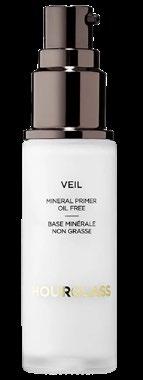
Primer: Hourglass Mineral Veil
Primer for very oily skin: One Size Oil Sucker

Summer is the time to simplify. Ditch full-coverage foundations and try a lightweight skin tint or BB cream. Cream blush and bronzer melt beautifully into skin for a sun-kissed glow. And don’t underestimate the power of a peachy or rosy blush — it brightens the whole face.
5

My favorite summer ritual? A weekly ice facial or chilled jade roller in the morning. It de-puffs, boosts circulation, and wakes you up — all in under two minutes. Bonus: it feels like a mini spa moment in your own kitchen.

m o d e s t e m p i r e
m a l k a m a j e s t y o f f e r s e l e g a n t , m o d e s t f a s h i o n
f o r e v e r y o c c a s i o n - f r o m c a s u a l w e a r t o
s t u n n i n g S h a b b a t & Yo m To v d r e s s . T h e c o m p a n y
s t a r t e d o f f a s m a l k a m a j e s t y g o w n s w h i c h c a r r i e s
b r i d e s m a i d g o w n s a n d l a t e r e x p a n d e d t o m a l k a
m a j e s t y b r i d a l ; t z n i u t g o w n s f o r b r i d e s - t o - b e .
L a u n c h i n g s o o n - m a l k a k i d s , a c o n t e m p o r a r y
m o d e s t k i d s c l o t h i n g l i n e f o r a g e s 4 - 1 4 .
C o n v e n i e n t l y l o c a t e d i n H o l l y w o o d , F L .
S h o p o n l i n e o r i n s t o r e a t t h e
m o d e s t m a r k e t w i t h o v e r 1 5 m o d e s t b r a n d s .
4 8 1 4 S W 2 8 t h Te r r a c e , F o r t L a u d e r d a l e , 3 3 3 1 2 .
F o r m o r e i n f o r m a t i o n c o n t a c t 9 1 7 . 8 3 0 . 4 4 7 8
I N S TA G R A M : @ m a l k a m a j e s t y
@ m a l k a m a j e s t y g o w n s @ s h o p m o d e s t m a r k e t




By: Deborah Malka
Paris. Fashion Week. From sidewalks to runways, eyes are hidden behind sunglasses even in broad daylight, and clothing... minimalist (let’s put it nicely).
And me? I’m wearing my long skirt, my threequarter sleeves, my denim (or golden) boots, depending on the mood, and purple nails that spark more conversation than a debate on pension reform.
And of course, that draws attention.
At Passover, in a super frum club, a girl looks at me and asks:
But why do you wear so many rings?
Why are your nails purple?
Why are you wearing golden boots?
And the best one:
Why do you need to dress like that?
Do you need attention?
Do you want to be noticed?
Well first of all... I’ll throw the question back at you, darling: why do you need to dress like everyone else? What is this, an episode of Black Mirror where we’ve entered the age of cloning? Great season 7, by the way. What I find crazy is that I would never say to



Because really, the topic here isn’t boots or purple
It’s allure. And when I say allure, I don’t mean “what
Allure is the combo of who you are, what you
Because sometimes, people think that following the Torah means living in black-white-navy. It’s the opposite! Torah is a framework for creation. It’s like the rabbanim when they write books — they’re not just doing Ctrl+C / Ctrl+V of the Talmud.

Not at all. They take the text, reflect, question, open windows in their minds.
And that is exactly what Hashem wants. He doesn’t want you to be a robot who repeats. He wants you to internalize, to feel, to transform the Torah into a way of being.
And the amazing thing is: the more you respect the foundations, the more you can be yourself without getting lost.
Tzniut isn’t a punishment. It’s a compass.
And allure? It’s what you build with it. It’s your flow, your fire, your flame as a princess of Hashem. So no, I’m not going to take off my rings, or put away my boots, or repaint my nails in “pleaseaccept-me beige.”
Because I already accept myself. You’re allowed to shine too.
But always in the light of the Torah. Because it’s not by exposing yourself that you’ll exist.
It’s by being aligned.
And that, that’s called having allure. No need to shock.
No need to disappear either.
Be an original creation in a world full of copies. That’s elegance. That’s true strength.
That’s the allure! Kisses, dear.
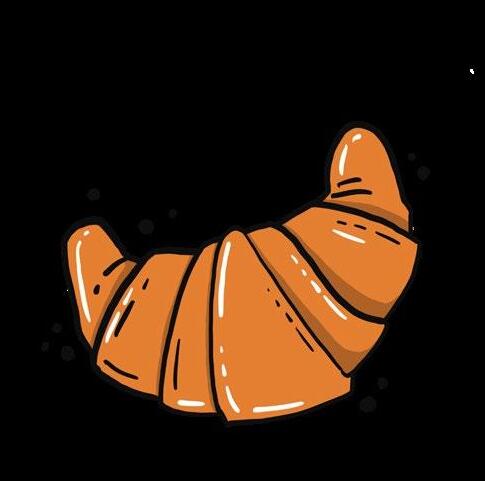
By: Barbara Wolf
Gloria Feinstein was born on December 1, 1955, in Buenos Aires, into a Zionist home. In the mornings, she attended a public school, and in the afternoons, she went to the “Schule de San Martín,” where she studied Yiddish and learned scattered bits about Jewish holidays.
Her only connection to religion was visiting her great-grandmother’s house to eat kneidlach soup on the night of Lel HaSeder. She knew nothing about the prohibition of bread on Pesach, Shabbat, or the laws of kashrut. She grew up completely disconnected from Jewish traditions.
Life in that environment led Gloria to develop anti-Jewish sentiments, which intensified during the long periods she spent in a town in the Buenos Aires province, where her grandfather David, of blessed memory, worked as a notary. No Jews lived there, and antisemitism was part of the local atmosphere—a view she absorbed without questioning. No one ever told her otherwise.
This turned her into a teenager who repeated antisemitic phrases without a second thought, like saying, “Jews only care about money, jewelry, and fur coats.” It took her years to dismantle those prejudices

again and settled in Israel. Years later, after her mother passed away, her father decided to return to Argentina. Gloria stayed. She had already met Adrián, now her husband, who was also from Argentina. Together they embarked on an intense spiritual search—something to fill the void they felt. Their journey began at an ashram in Spain, where they spent eight months. Then they traveled to Ecuador and later to the jungle in Venezuela. But in all those places, the only thing they found were gurus trying to control their lives. Their spirits remained alone and unsatisfied.
However, it was in that last destination that the idea of returning to Israel began to take shape. Gloria’s brother played a key role in this return. He began writing them letters describing his journey of Teshuvah (returning to Judaism), sharing the concepts he was learning and how much they were positively transforming his life. He urged them to come back: “Here, you’ll find all the answers to your questions.” And so, full of hope, strength, and longing, they arrived in Kiryat Arba, in Hebron, Israel, determined to deeply explore the world of Torah.
That’s where her journey of Teshuvah began—and it wasn’t easy. There were ups and downs, but she walked the path hand in hand with people who supported her unconditionally, without judgment, giving her the emotional support she needed to move forward. Gloria says, “It was thanks to my husband’s love and patience with my pace—which was usually slower than his—that I was able to go through it with joy and happiness.”
Along this path, she admits, some things surprised her. She realized she had carried certain signals within her since childhood that she hadn’t understood before. For example, when she began learning about modest dress among Orthodox women, she remembered how uncomfortable
She leaves us with this message:
she used to feel wearing a bathing suit on the beaches of San Bernardo, Buenos Aires, during family outings. That’s when she understood the deeper origin of that discomfort: her Jewish soul was speaking to her, even though she didn’t yet know how to interpret it.
Today, Gloria has a beautiful family with eight children, thirty-six grandchildren, and two great-granddaughters, Baruch Hashem. She spends her days welcoming people who want to discover Hebron, its ancient and modern history. She volunteers with families affected by terrorism, offering art therapy, leads laughter therapy workshops for elderly women, and has written two books: From Buenos Aires to Hebron and For All the Mothers of the World.
“Life in Israel is sweet. We are here because it’s a sacred place, full of spiritual energy and beautiful love. We continue to choose Hebron because we know it matters—and that only if there are Jews here will the rest of the country continue to exist. It’s true that it’s a dangerous place and that we’ve lived through many terrorist attacks, but we know how important this place is for the Jewish people, and we feel that someone has to protect it. Come to Hebron—your roots are here. I’m waiting for you!”



Mikhal is a bridge between sacred tradition and modern beauty, a way to celebrate Jewish heritage in everyday life.
Each piece carries the soul of ancestral rituals, reimagined with elegance and intention, reminding us that holiness can live on your table, your shelf, your space.

Mikhal.Shop
Mikhal.Shop
shopmikhal@gmail com

Discover our signature creations:
Challah Covers
Havdalah Sets
Shabbat Sets
Art de la Table
Curated Holiday Boxes
Rosh Chodesh Box
From weddings to mitzvahs and beyond, we create custom Judaica to elevate every moment, kippot, challah covers, Shabbat boxes, mikveh gifts

Judaica, made personal

By: Esther Sitbon
TIt is the quiet pause at the end of a day of giving. A soft exhale after holding, nurturing, deciding, guiding. In that moment, without words or effort, we let go. And in that letting go, something divine happens.
The Torah teaches that sleep is not just rest — it is return. A return to essence. A return to faith.
Each night, our soul rises. Not in rebellion, but in trust. We release our grasp on the world, and we allow Hashem to hold us. We say the Shema, close our eyes, and offer our soul back into His keeping — like a child curling into her mother’s arms.
This surrender is deeply feminine. In a world that praises doing, producing, controlling, the act of sleep calls us back to the holy art of receiving. The Kabbalists associate night with Malchut, the feminine vessel that receives light — not passively, but with dignity, openness, and inner strength.
Sleep is our way of saying: I don’t need to carry it all. I can rest. I can trust. I can become a vessel for what is yet to come.
The mystics speak of sleep not as absence, but as preparation. While we rest, the soul is being gently bathed in light, whispered to by Heaven, healed and realigned. We awaken not
only refreshed, but more whole — even if we cannot always name what changed within us.
In a world that rarely allows for stillness, this is revolutionary.
To close our eyes with intention. To let go of control. To feel that we are not alone. This is not weakness — this is emunah.
It’s no wonder that the Jewish day begins at night.
The first step is not action. It is trust.
Before we build, we rest. Before we shine, we receive. Before we rise, we release.
There is something so beautifully feminine about this rhythm. It honors the cycles within us. It teaches us that true strength is not only found in motion — but also in surrender, softness, stillness.
So tonight, let sleep be more than recovery. Let it be a return. A holy surrender. A quiet prayer.
You do not need to carry it all to be worthy. You do not need to strive endlessly to be whole. You are allowed to rest. To trust. To be held. Sleep, then, becomes a sacred whisper: Even now, even here, Hashem is with me. Even in the dark, I am never alone. Even in stillness, I rise.

By: Mercedes Benavidas
It’s no secret that people today are sleeping less than in the past. In 1960, the average person slept about 8 hours per night; by 2012, that number had dropped to around 6.5 hours — a reduction of 20–30%. Cutting down on sleep has a dramatic impact on our hormones and metabolism.
Sleep is one of the fundamental pillars of our health. Although it is often underestimated, its effect on body weight and hormonal health — especially in women — is profound. Science has shown that proper rest is not only crucial for cell regeneration but also regulates key aspects of metabolism and appetite. Lack of sleep can trigger a series of hormonal changes that promote weight gain, directly affecting our ability to maintain a healthy weight.
Sleep and weight are closely linked through several essential hormones. First, leptin, which regulates appetite, decreases when we don’t get
enough sleep. This leads us to feel hungrier and eat more — especially high-calorie foods. On the other hand, ghrelin, the hormone that stimulates hunger, increases with lack of sleep, which can cause intense cravings. In addition, insulin, which regulates blood sugar levels, is disrupted — contributing to fat accumulation, particularly in the abdominal area.
What’s most relevant is that these hormonal effects are particularly intense in women, since our hormonal cycles change with each phase of the month, making our responses to sleep and weight more variable than in men.
During the summer, our sleep routines can be affected by various factors. Long daylight hours, heat, and more flexible schedules can disrupt our sleep patterns. Prolonged exposure to natural light interferes with the production of melatonin, the hormone that helps us relax and fall asleep. Additionally, the combination of high temperatures and lack of a consistent routine can make us feel more tired and therefore more likely to make

Follow on instagram @foodtrition_life
unhealthy food choices. So what can we do to improve our sleep patterns during the summer?
- ESTABLISH A NIGHTTIME ROUTINE: Create a relaxing set of activities like reading, taking a warm bath, or practicing deep breathing to signal to your body that it’s time to rest.
- KEEP YOUR BEDROOM COOL: Use fans, air conditioning, or even fresh sheets to reduce heat and create a sleep-friendly environment.
- AVOID ELECTRONIC SCREENS: Blue light from phones and computers interferes with melatonin production. Turn off these devices at least one hour before bed.
- EAT SMART: Choose light, nutritious dinners that won’t overload your digestive system. Remember, as darkness sets in, your body produces less hydrochloric acid and digestive enzymes.

- SPEND TIME IN NATURE: This is one of the smartest and most cost-effective ways to sync your circadian rhythm and help regulate your hormones.
For all of us working to care for our well-being, protecting our sleep should be just as important as the quality of supplements you buy, the cream you use on your face, or even the love and effort you put into cooking healthy meals and buying organic food. Sleep helps integrate and regulate our hormonal and metabolic cycles. It helps cleanse the liver and activate the glymphatic system in the brain — the brain’s detoxification process — helping us maintain a stable weight.
Sleeping 7–8 hours a night should be part of your nutritional strategy to support your weight.
Wishing you a good night.
Mercedes Benadivas RD, LDN, CLT, IFNCP

“ Waiting for heart disease to happen is not the right approach”



By: Sarah Rosanel
revention is the most powerful tool in the fight against any diseases. By adopting heart-healthy habits early and monitoring key risk factors, women can significantly reduce their chances of developing lifethreatening conditions.
A heart-healthy diet is the foundation of prevention. The secret to keeping your heart in top shape lies in a well-balanced, nutrient-dense eating plan that incorporates a variety of foods from all food groups. Nutrient-rich foods provide the vitamins, minerals, protein, and fiber your body needs to thrive. Prioritizing heart-smart foods can help regulate weight, cholesterol, and blood pressure, reducing the risk of heart disease.
Focus on Whole Foods: Think fresh! Load up on fruits, vegetables, whole grains, and lean proteins.
Limit Harmful Additives: Cut back on saturated fats, trans fats, sodium, and added sugars.
A well-rounded, whole-foods diet supports your overall well-being and acts as your first line of defense against heart disease.
Heart-healthy eating is not just about what you eat—it’s also about how much. Embrace portion control to avoid overeating. Try using smaller plates, measuring your servings, and ensuring each meal is balanced with vegetables, lean proteins, and
whole grains.
Preparing meals at home gives you control over ingredients and cooking methods. Opt for healthier cooking techniques like baking, grilling, or steaming over frying.
Heart disease doesn't discriminate—it affects young adults just as much as it does seniors. Waiting for symptoms to show up is not the way to go. In fact, half of heart attacks are fatal before individuals even make it to the hospital. The good news is that prevention starts early.

Teaching children and young adults about nutrition, physical activity, and stress management can lay the groundwork for a lifetime of heart health.
For those with diabetes, managing insulin resistance and high blood sugar is essential. Additionally, elevated LDL cholesterol (the "bad" cholesterol) and low HDL cholesterol (the "good" cholesterol") can lead to plaque buildup in the arteries. Regular health checkups and dietary adjustments are key to managing these risks effectively.
"Waiting for heart disease to happen is not the right approach," says Dr. Sarah Rosanel, MD, FACC. "Prevention through early intervention is crucial to protecting your heart—no matter your age." Take control of your heart health today to pave the way for a stronger, healthier tomorrow. Don’t wait—your heart will thank you.

Dr. Sarah Rosanel is a dedicated concierge physician based in Miami, FL, specializing in personalized healthcare tailored to the unique needs of her

With a holistic approach that blends traditional medicine, lifestyle interventions, and functional medicine, she empowers individuals to achieve
optimal health and well-being. As an expert in Concierge Medicine & Cardiology, Dr. Rosanel integrates cutting-edge medical treatments with holistic methodologies, ensuring comprehensive care that goes beyond symptom management to address the root causes of health concerns.
Beyond her medical practice, Dr. Rosanel is a devoted mother to Ariel, Zev, and Shirley, balancing her passion for healing with family life.









By: Esther Sitbon
In Jewish tradition, eating has always been more than a physical act. It’s a moment of connection — to ourselves, to life, and to something higher. The foods we choose, the way we prepare them, and the presence we bring to each bite can shape how we feel — not just in our bodies, but deep within.
Our bodies are sacred vessels, designed to carry our thoughts, our dreams, our light. When we eat with love and intention — choosing foods that are clean, vibrant, and nourishing — we create space for clarity, strength, and joy to flow more freely.
And then comes Shabbat. A day of delight, of rest, of sweetness. In the warmth of summer, we long for the joy of oneg Shabbat — that special pleasure — but without the heaviness or guilt. This is where conscious creativity meets tradition. A dessert that feels festive and indulgent, yet leaves us feeling light and well. This layered smoothie cake is just that: refreshing, wholesome, and made to honor the beauty of Shabbat — in a way that nourishes both the body and the soul.
Because holiness lives in how we feel. And Shabbat is meant to feel beautiful — inside and out.

A refreshing and healthy Shabbat dessert in just 20 minutes

This layered smoothie cake is a celebration of vibrant fruits, creamy texture, and wholesome sweetness — the perfect way to enjoy oneg Shabbat without the guilt. Ideal for summer, it’s dairy-free, refined sugar-free, and entirely plant-based.
Base Smoothie Layer – Mango
2 ripe bananas
1 bag (approx. 400g) frozen mango
1 cup orange juice
Middle Smoothie Layer – Pineapple
Coconut
2 ripe bananas
1 bag (approx. 400g) frozen pineapple
1 can (400ml) full-fat coconut cream
Top Smoothie Layer – Strawberry
2 ripe bananas
1 bag (approx. 400g)
frozen strawberries
1 can (400ml) full-fat coconut cream
Optional (to add to any layer):
1–2 tbsp vanilla or plain vegan protein powder (pea-based)
To Decorate:
Fresh fruits (berries, kiwi, mango, coconut flakes, edible flowers)
Tools:
Blender
Silicone mold or springform pan with removable bottom
Freeze
1. Prepare the mold:
Place your silicone mold or springform pan in the freezer to chill while you prepare the first layer.
2. Layer 1 – Mango:
Blend 2 bananas, frozen mango, and orange juice until smooth.
Pour into the mold and freeze for 30–40 minutes, until the layer is slightly firm.
3. Layer 2 – Pineapple Coconut:
Blend 2 bananas, frozen pineapple, and 1 can of coconut cream until smooth.
Gently pour over the first layer. Freeze again for 30–40 minutes.
4. Layer 3 – Strawberry:
Blend 2 bananas, frozen strawberries, and the second can of coconut cream until smooth. Pour as the final layer. Freeze the entire cake for at least 4 hours, preferably overnight.
To serve:
Let the cake sit at room temperature for 10–15 minutes before unmolding.
Decorate with fresh fruits of your choice and enjoy!


Vera Newman is a Panama-born cookbook author, event designer, and florist based out of Detroit, known for her unique ability to bring together flavorful, family-friendly dishes with an elevated flair. In this new book, the third in the Marblespoon series, Vera continues to inspire busy moms and home cooks with easy-to-follow recipes that make every meal a celebration. Vera’s cooking style is rooted in her love for nourishing food that brings families together around the table. With a focus on wholesome ingredients, her dishes offer a perfect balance of convenience and sophistication, allowing everyone to enjoy delicious meals together — from the youngest eaters to the adults.
Passionate about creating beautiful tablescapes, Vera is particularly known for her stunning Shabbos and holiday settings, where the table is as thoughtfully designed as the meal itself. Her social media presence, Marblespoon, reflects her creative journey in the kitchen and beyond, offering inspiration for anyone looking to add a little extra beauty and joy to their dining experiences. With each recipe, Vera hopes to share her joy of cooking and bring more meaningful moments to the table for families, no matter how busy life may get.

Follow on instagram @marblespoon

DAIRY | FREEZES WELL | YIELDS 18 TARTS
These handsome little tarts taste like crème brûlée, but without all the extra steps and technique. Super easy to make, the perfect afternoon activity for kids who like baking. These are a family favorite!
3 eggs, at room temperature
2 cups sugar
3 Tbsp butter, melted (see note)
2/3 cup all-purpose flour
2 cups warm milk (see note) nonstick cooking spray powdered sugar, for dusting
1 cup sliced strawberries, for optional garnish fresh mint, for garnishing, optional
Preheat oven to 350°F. Generously coat muffin pans with nonstick cooking spray.
In a large mixing bowl, use a fork or whisk to beat eggs, sugar, and melted butter until smooth.
Add flour; mix until smooth.Add warm milk; mix until smooth. Pour into prepared muffin pans, filling each cup ¾ full.
Bake on the middle rack of the oven for 25 minutes, or until golden brown. Allow to cool for 10 minutes before carefully removing from the pan. Dust with powdered sugar; decorate with strawberry slices and mint, if desired.
NOTE : Milk must be gently warmed on the stove or in the microwave for a few seconds, and eggs must be at room temperature.
This is my idea of comfort food. The combination of sweet potatoes and regular potatoes and the little flavor bombs that are these cozy and tender kebabs is so perfect, and the best part is that it all gets roasted at the same time in a sheet pan. Obsessed with this dish, I know you’ll be too!
1½ lb mini gold potatoes, quartered
1 large sweet potato, peeled and cubed
MARINADE
½ cup olive oil
juice of 1 lemon
¼ cup fresh parsley, plus more for garnish
1½ tsp sea salt
1 tsp paprika
¼ tsp black pepper
KEBABS
2 lb ground beef
2 eggs
1 cup breadcrumbs
½ small onion, finally diced
¼ cup fresh mint or parsley, finely chopped
1 large garlic clove, finely minced
3 Tbsp olive oil
2 tsp red wine vinegar
2 tsp sea salt
½ tsp paprika
½ tsp cumin
½ tsp crushed red pepper
¼ tsp black pepper
Preheat oven to 450°F. Line a large metal baking sheet with parchment paper. Prepare the kebabs: Add all the kebab ingredients to a large bowl. Mix until combined. Prepare the marinade: In a small bowl, combine the marinade ingredients. Place potatoes and sweet potato on prepared baking sheet. Drizzle with ¾ of marinade; toss to coat. Form kebab mixture into about 20 torpedoes; scatter around the potatoes. Drizzle with remaining marinade. Roast for 45 minutes. Garnish with additional fresh parsley, if desired.
TIP : This dish is best enjoyed fresh. Do not freeze.


Starter: Tuna Crudo in Citrus Green Sauce
Salad: Shredded Romaine Mango Salad
Soup: Zucchini Dill Soup
Main: Sheet Pan Kebab and Potatoes
Dessert: Custard Tarts


Marblespoon Tried and True A collection of colors, flavors, and vibrant recipes you can trust
Buy Here Made in PANAMA


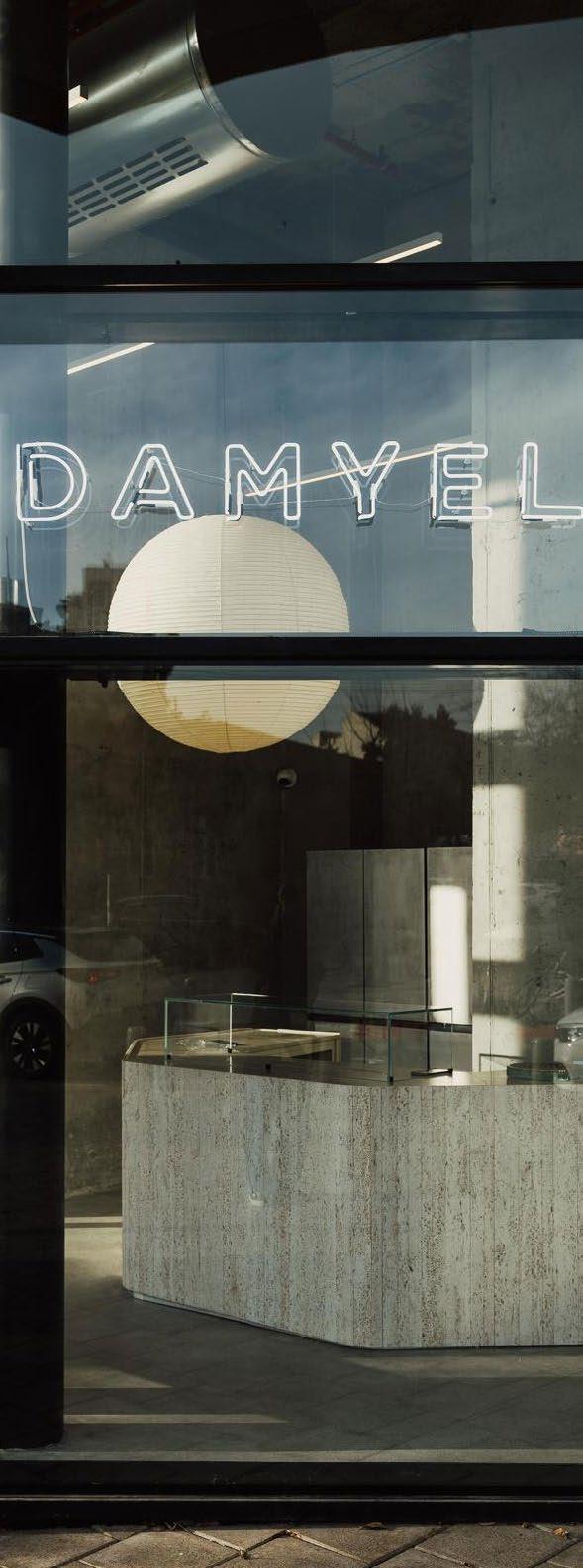
By: Evelyne Uzan
TThere are women whose nobility of soul shines through the simplicity of daily life — with a luminous and confident presence, far from the spotlight. Their light does not seek to dazzle, but to illuminate from within — with grace, conviction, and vision.
For them, gentleness does not diminish strength; it amplifies it. A calm strength, the kind found in a woman who knows how to lead, build, and inspire with elegance, dignity, and a tsniout that uplifts.
Mrs. Evelyne Uzan is one of these women.
The story of Damyel is the story of an inspired couple, of a business founded on faith, a pursuit of excellence, and a deep love of sharing. It is also the story of a name — David, Mihael, Yael — which has become synonymous with refinement and trust throughout the Jewish world.
In this heartfelt and sincere testimony, Mrs. Uzan shares with us the unique journey of the first kosher chocolatier, born in Paris, rooted in Jewish values, and now flourishing all the way to Tel Aviv.
It was 1990. In Paris, new Belgian chocolate shops were springing up and generating great excitement.
My husband Richard Z”L was intrigued by this trend. He saw in it a unique opportunity: why not launch into this world, but bring something new — kosher chocolate?
At the time, I was still working in another profession. The idea seemed unexpected, but I felt something special was about to be born. Richard, who had trained at Lenôtre, immersed himself in the world of chocolate with passion. He learned quickly, discovering the richness, finesse, and precision required by this noble craft, and embarked on the journey with enthusiasm.
We then presented our project to Rabbi Rottenberg Z”L to receive his blessing and the supervision of the Orthodox Grand Rabbinate. The name of the project came to me as an obvious choice: by combining the names of our children — David, Mihael, and Yael — Damyel was born.
From the outset, Richard made a bold decision: all our chocolate would be parve. His goal: to offer consumers the pleasure of enjoying chocolate any time of day, with full kosher certification.
In 1995, I fully joined the company and opened our first Parisian boutique. The public responded enthusiastically. Five more shops followed. Around this time, our first signature creation came to life: the Damyel praline — a generous, playful chocolate with smooth praline, a memorable flavor.
In 2005, our eldest son David joined the family business. Damyel entered a new era, while remaining true to its essence. Richard and David shared the same commitment to craftsmanship, respect for the product, and attention to detail. I would say there is a soulful quality to Damyel. Turning a kosher product into one of true excellence is, for us, a source of pride. From the workshop to the window display, everything must reflect that excellence.
I’ve always believed that the packaging honors the creation. It elevates the intention, and highlights the artisan’s skill. David and I have always had a taste for beauty, simplicity, and timeless elegance. That refinement is part of the Damyel experience. And because the standards of kashrut guide us daily, we naturally took a new path: vegan chocolate. A challenge we embraced with passion. Today,


we are proud to be certified 100% French Vegan, a bold move that sets us apart from traditional chocolatiers. One of our signature creations to discover: Damyel’s dark vegan chocolate.
Today, Damyel is known far beyond France, cherished throughout the global Jewish community — a source of deep pride for us. And the journey is still unfolding: just three months ago, we opened our first boutique in Tel Aviv. I’m personally there, guiding the Damyel TLV team to carry forward our love for beauty, our respect for each creation, and the attention to detail that defines us. At Damyel, we believe the pleasure of choosing a gift is just as meaningful as the joy of giving it — both moments deserve to be savored.
To all the Jewish women reading this, I want to say: to me, entrepreneurship is a profoundly Jewish value. For centuries, our people have learned to adapt, innovate, and rebuild. To be an entrepreneur is to open a space of freedom. It means listening to your intuition, believing in your dreams, and walking forward with emunah, without fear. So to each of you: dare. Take the first step. Even if the path seems uncertain, the light is waiting for you.
And to end on a lighthearted note: we were recently asked to create a bust of... Donald Trump, entirely in dark chocolate! We made it. The rest of the story? We don’t know yet — but it definitely made us smile.



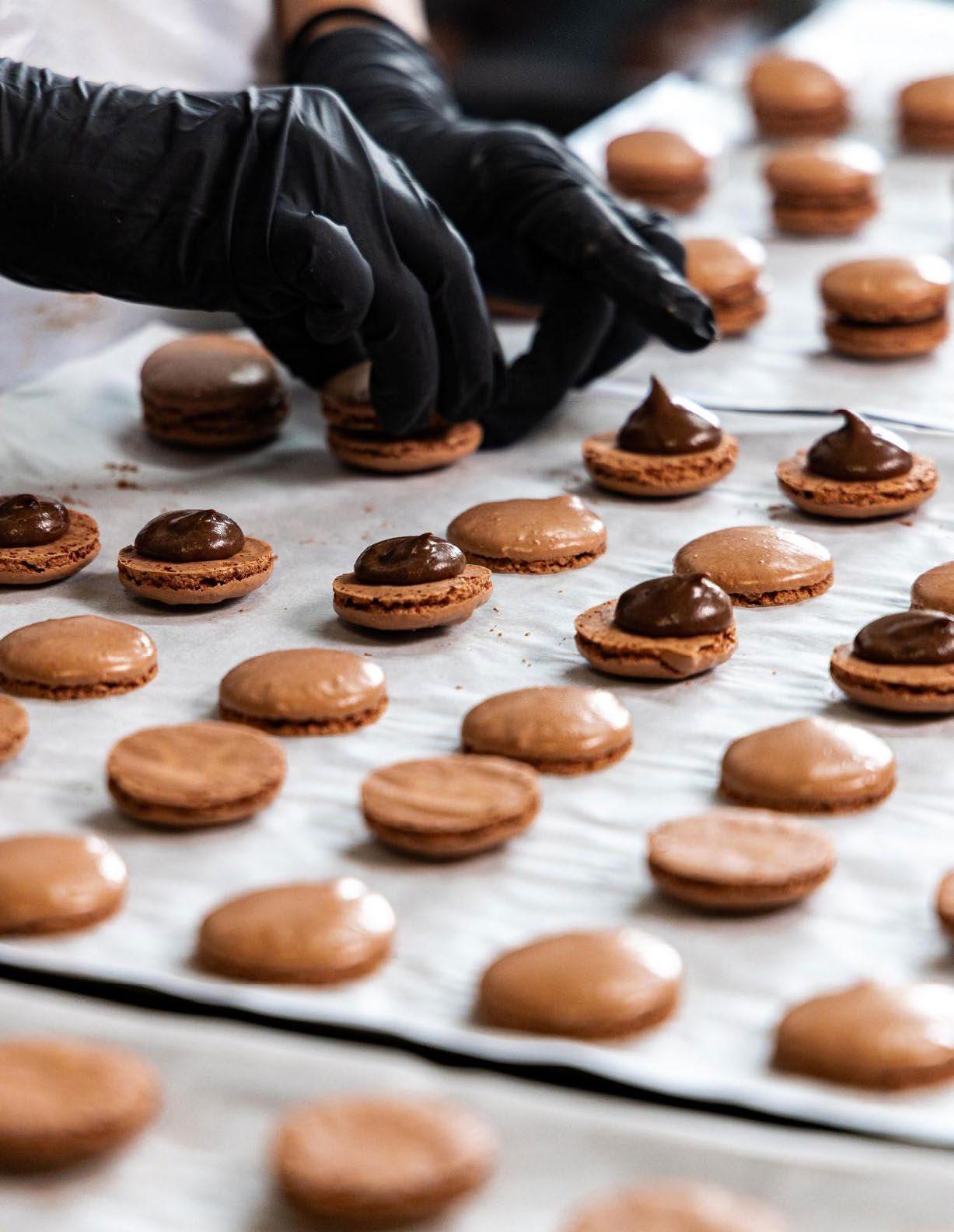
Between the yelling, the bickering, and the “I’m so tired of this mess!”, many of us dream of a calm, peaceful home. While we may not be able to control the chaos, there’s one thing we can always take charge of: ourselves. This article offers an inner compass to better understand what triggers us, what irritates us… and more importantly, what can truly transform our day-to-day. Because the real strength of a mother (or a father) isn’t to control everything, but to practice self-control. And that’s what truly matters.

1.
We don’t all react the same way to the same situation. A ball in the living room may make one laugh and deeply irritate another. Some can live with mess; for others, it feels oppressive. It’s not the event itself that creates tension, but how each person experiences it. A peaceful atmosphere starts with knowing your own sensitivities—without guilt or judgment. This inner work helps you anticipate situations and respond without overreacting.
2.
We may know all the parenting theories, but when stress rises, they fly out the window. Why? Because human beings aren’t just vessels for knowledge—we’re emotional beings with personal histories. What triggers our yelling or criticism are emotional buttons: sibling fights, lies, disrespect. Identifying these “sensitive zones” helps us step back and respond calmly and wisely. Knowing our triggers is the key to greater selfmastery.
3.
But parenting is about persistence—the parent’s perseverance must outlast the child’s resistance. Don’t take things personally. Mess isn’t an act of rebellion. What matters is turning blame into direction: “Please clear the table now,” instead of “You never help!” Guide without crushing, direct without exploding.
much and struggle with reality. Superlatives feed pride, comparison, and a lack of effort. It’s more effective to highlight the real effort: “You persevered,” “You did your best.” Because true success lies in the effort, not just the result.
5.
The key? Learn to stay quiet when emotions rise—not from weakness, but from strength. Speaking while emotionally agitated is like driving drunk—wait until you’re “sober” to take the wheel… or speak. Train yourself to pause, delay your reactions, and speak to yourself before you speak to others. This work on yourself, with yourself, is what creates peace around you. The atmosphere at home starts with the one you cultivate inside.

6.
Encouragement is essential, but it must be grounded. Telling a child “you’re the best in the world” can backfire: they might not believe you and feel discouraged, or believe it too much and struggle with reality. Superlatives feed pride, comparison, and a lack of effort. It’s more effective to highlight the real effort: “You persevered,” “You did your best.” Because true success lies in the effort, not just the result.
4.
What poisons the atmosphere are constant complaints: “You didn’t clean up—again!” or “This is impossible!”
When a child makes a mistake, we often react with drama and raised voices. Often, our stress, fatigue, or frustration over our own failure makes us more vulnerable. We already felt overwhelmed—and now this! It’s hard. But that’s when we need to rise higher: staying connected to our child, even in their mistake. Just like we would for a friend. This unconditional support is a powerful educational tool. Walking alongside a child through their storm—without letting go—builds the inner security they desperately need. Cultivating a positive atmosphere at home starts with cultivating inner peace. It takes self-awareness, emotional refinement, and the sincere will to grow—one step at a time. Because by becoming strong, kind, and stable adults, we offer our children the greatest gift of all: a home where it feels good to grow.

Create a peaceful home by starting within. Discover tools for calm, connection, and conscious parenting. Order now

Interview by Esther Sitbon for Lehaalot Magazine
From her home in Buenos Aires, Sheila Krivopisk speaks with a rare softness — the kind that carries wisdom wrapped in humility. She is a Jewish artist, a mother, a woman of depth and resilience, whose journey of faith and selfdiscovery is embroidered, quite literally, into the works she creates. In this intimate conversation, Sheila opens her heart to Lehaalot founder Esther Sitbon, sharing how moments of silence, isolation, and yearning gave rise to a renewed sense of self, a spiritual mission, and the surprising discovery of her artistic voice.
Lehaalot, which means to elevate, could not have found a better guest for its sacred mission — because every thread of Sheila’s story is about upliftment: of the soul, of pain, of the people around her, and ultimately, of the light she now shares with the world.

Esther Sitbon: Sheila, it’s truly a pleasure to have you here with us today on the Lehaalot podcast.
Sheila Krivopisk: Likewise. Thank you for inviting me.
Esther: Thank you for entering my life — and in such a special way. I feel there’s a deep connection between us. And today, I’m so curious to know more about your journey. How did you become such a generous, spiritual artist? So again — thank you for accepting this invitation.
Sheila: It’s a pleasure to be here.
Esther: Where are you now?
Sheila: I’m in the living room of my house, in Buenos Aires, Argentina, where I live.
Esther: Beautiful. Let’s begin with a favorite Lehaalot question: If your life were a book, what would its title be?
Sheila: (smiling) You’re already making me think… I’d call it Climbing My Own Ladder.
Esther: Wow. I love it. You know that Lehaalot means “to elevate”?
Sheila: No, I didn’t! But yes — Climbing My Own Ladder. That’s how it feels. It’s about the journey. Everything I’ve lived to become who I am today.
Esther: Tell me a little about your childhood. Where did you grow up?
Sheila: I was born in Buenos Aires. My parents were also born here, but my father’s family is from Romania, Poland, Russia… and my mother’s side is from Aleppo, Syria. So my life has always been a mix of two very different cultures and flavors. That blend gave a lot of richness and color to my childhood. I have two siblings — my older sister Vanessa, who also lives in Buenos Aires, and a brother in São Paulo, Brazil. I’m the youngest.
Esther: Was your family always connected to Judaism?
Sheila: Yes, we went to Jewish school. And later, a friend introduced my father to Chabad Lubavitch — that began a new chapter for our family. But since we were already a bit older, each of us had our own personal path.
Esther: Being the youngest — did it touch you more?
Sheila: At the time, not really. My journey with Judaism felt more individual and slower to unfold. I accepted the changes — like my brother wanting kosher meat — but I hadn’t started my own path yet. That came later.
Esther: What sparked that personal journey?
Sheila: I studied tourism and hotel management at the University of El Salvador — a Catholic university here in Buenos Aires. After a lifetime of Jewish schooling, it was a huge change. I was 18 or 20. Suddenly, I was in an environment where I was the only Jew. And people would ask me questions — simple things — like “Why do you light candles?” or “Do you speak in a dialect at home?” And I didn’t have answers. I had always done Jewish things out of habit, not understanding. But there, for the first time, I realized I didn’t really know why. That’s what woke up my search. I started learning more — first through Chabad, through Rabbi Shlomo Levi who worked with Jewish youth. And little by little, I began to not only practice Judaism, but to really feel it. It wasn’t inherited anymore. It was mine.
Esther: That’s so powerful. Did your husband grow up with a connection to Judaism as well?
Sheila: No — actually, we met in Miami at a hotel we both worked at — the JW Marriott. He’s Argentine too, but had no connection to Judaism before. His first contact with it was… me. (laughs) At the beginning, I was more involved. But now — wow — he’s surpassed me! Today we’re Shomer Shabbat, we keep kosher, and we live a very full Jewish life. Our community, Wolfsohn in Núñez, has also been an immense blessing. It’s where we truly learned how to give — we received so much, and that awakened a sense of service in us.
Esther: That’s beautiful. So how did you go from hotel management… to art?


Sheila: After Miami, we returned to Buenos Aires. I started working as a chef — I’d always loved food. But during that time, we were going through a very hard journey. I had to rest a lot. Projects kept being paused.
Then came the pandemic. I was already into ceramics at the time, creating and selling small pieces. But in Argentina, we couldn’t leave the house — not even to buy groceries. My husband worked in food packaging, so he was considered essential and kept going to work. But I stayed home — alone. One day, scrolling the internet, I stumbled on a technique I’d never heard of before — punch needle embroidery. I didn’t know how to do it, and I wasn’t someone who had been good with thread. But something about it called me. I found an online course and started practicing. At first, I made abstract things… and then, I made the Rebbe. A tapestry of the Rebbe with his hand held up and you see a baby. Which is a segulah to have children. I don’t know why I chose that image. I didn’t plan it.
But I finished it — and then, my sons came into my life, my family was filled. Life changed.
Esther: That’s so moving. And you stopped embroidering for a while?
Sheila: I had to. I was busy weaving my family instead. I donated the tapestry to a mikveh that was still under construction — so I held on to it until it was ready.
Two years later, I found the embroidery again. I had more time. I needed a creative space for myself. Eventually, the tapestry was donated to Olei Chinuch, the Lubavitch school in Buenos Aires, as part of a fundraiser. So many people approached me and asked, “Do you sell these?”
I hadn’t planned to — it was just a hobby. But I thought, Why not try?
And that’s how the journey began. The second piece I ever made ended up with the president — in the Quinta de Olivos. And since then… Baruch Hashem. I’ve grown. I’ve connected more deeply with each face I create. There’s a relationship that forms between me and the soul — the neshama — that I’m bringing to life.
Esther: I imagine it’s very meditative?
Sheila: Completely. It’s just me and the thread, dot by dot. And suddenly — there it is — a face. A presence. It amazes me every time. And the most beautiful part? The technique allows for mistakes. You can undo. You can redo. And that’s life. You make mistakes, and you reweave. You grow. You get to try again.
Esther: The second chance.
Sheila: Yes. And you give yourself permission to evolve.
Esther: Do you think this talent was always in you, even as a child?
Sheila: I think yes. I had manual skill — but more than that, I had an eye. A friend once told me, “You always saw the extra eyebrow hair no one else noticed.” (laughs) That attention to detail — it was always there. And now, I use that same ability to see what others don’t — to pull out what’s hidden in a person’s expression and reveal it in art.
Esther: It’s amazing how physical talents reflect spiritual ones. You went from removing what doesn’t belong to revealing what does.
Sheila: Exactly. And yes — I see the details. All of them. It’s a blessing… and sometimes a challenge. It teaches me to be patient. To forgive myself. To remember I can’t fix everything. That sometimes, it’s okay to just be.


Esther: Earlier, you named your book Climbing My Own Ladder. What does that mean to you?
Sheila: I once read this idea that when we leave this world, Hashem shows us not only what we became — but what we could have become. And the pain is realizing the distance between the two. So I want to know that I used everything I was given. That I didn’t waste the time, the talents, the chances. That I climbed my ladder — not someone else’s. That I became who I was meant to be.
Esther: And you’re helping others do the same — by creating art that elevates them, by being present for your family, by sharing your light.
Sheila: I hope so. I believe each of us has a mission no one else can fulfill. And we have to reveal it. We have to make it shine.
Esther: Thank you, Sheila. For your presence, for your art, for your journey. You embody so much of what Lehaalot stands for: taking a spark, and letting it rise.
Sheila: Thank you, Esther. It was a pleasure speaking with you. Thank you for the beautiful questions, for your warmth, and for everything you’re doing through Lehaalot.

Watch the full conversation here

Follow on instagram @sheilakrivopisk
Acurated selection of tableware, glassware, and table accessories with bold design and noble materials, designed to create atmospheres that combine elegance and audacity. Each piece is chosen to inspire, elevate the everyday, and turn every meal into a special moment.
By Maison Maizon
Summer is an invitation to softness, light, and shared moments around a beautiful table.
At Maison Maizon, we believe that hosting is an art—the art of creating beauty in daily life, of celebrating the moment with intention and elegance.
Here are two tables imagined to enhance the season:
One for everyday summer meals, with a touch of spontaneous elegance; The other for a vibrant and sunlit Shabbat.
Two atmospheres, one shared desire: to make every meal a moment of joy.
Designed for daily meals where you want to treat yourself, this table combines refinement and freshness. The bold pairing of deep violet and lemon yellow structures the setting with flair. Graphic plates, colorful hand-blown glasses, and carefully selected flowers give the table a joyful, luminous, yet perfectly balanced spirit.
Placemats inspired by Mediterranean art and architecture add a graphic backdrop that grounds the composition. This table shows that elegance isn’t just for special occasions—it can be lived daily, through attention to detail and the joy of beauty.
Colors: Bright yellow, deep violet, emerald green
Mood: Bold, joyful, elegant without overdoing it
A Radiant Summer Shabbat
When Shabbat arrives, the table is elevated. Here, the inspiration comes from the sun, celebration, and abundance. A saffron-yellow and white tablecloth sets the stage for vibrant tableware with solar and geometric patterns. Sculpted turquoise candlesticks add rhythm with elegance, while decorated glasses, tiered plates, and small transparent bowls add refined touches throughout. Every detail contributes to a festive, luminous, and deeply harmonious atmosphere.
Colors: Turquoise, saffron, burnt orange, gold
Mood: Sun-drenched, generous, refined
Maison Maizon – Hosting is Creating Beauty
At Maison Maizon, we imagine tables as life scenes: beautiful, lively, generous. Through lovingly selected objects—dishes, glassware, textiles—we help you turn every meal into a moment of emotion.








Dear Sarah/ Soul Season, Summer Edition Question:
“It feels like everyone is going somewhere this summer — vacations, family trips, beautiful places. I see people posting their highlights, planning their getaways, sharing their adventures. And honestly, I don’t really have anything big planned. I’m not traveling far, and I don’t feel like I have much to ‘show’ for the summer. Is summer really only meaningful if we’re on the move? Is there value in a quieter summer?”
What a beautiful and honest question. You are not alone in this feeling — and your question touches something deep and real.
It’s easy to feel out of place in a season where movement and showcasing seem to define success. With the constant stream of highlight reels and sunset selfies, summer can start to feel like a race — a pressure to perform, to post, to prove we’re living our best life.
But Chassidic Masters teaches us to look beneath the surface. Beneath the pace. Beneath the noise. And what we find is that summer is not only a time to travel outward — it’s an invitation to journey inward.
In the soul’s calendar, summer is a season of pause and softness, a time of reflection, introspection, and quiet rebuilding. The months of Tammuz and Av in the Hebrew Calendar —though often associated with mourning — are also deeply tied to spiritual regeneration. In thispause from routine, we are gifted with something rare: space. Space to be with ourselves.
Space to ask: Where am I in life? What kind of woman do I want to become? How do I wish to grow, stretch, deepen?How can I live with more purpose, more presence, more meaning? The stillness allows you to listen in ways that movement often drowns out. It gives room to confront, to wonder, to imagine again. Personally, I’ve found that when the world quiets down in the summer, something stirs within me. I begin to reevaluate how I’m living and where I’m heading.
There is something so profoundly holy about slowing down enough to really hear your own soul.
I sit with myself, not always comfortably, but honestly.
I give myself permission to dream without pressure and to ask without judgment. It’s in these quieter moments that I begin to expand my mind and open my heart. I begin to allow new visions to take shape. And while there may be no passport stamps or packed itineraries, what unfolds is something incredibly rich: a deeper connection with myself and with G-d.
And you know what? That kind of reflection —the kind that takes courage and presence — is just as satisfying, just as rich and memorable, as any caption under a breathtaking sunset.
Maybe even more so. Because while the sunset fades, what you discover in yourself stays with you.
So if your summer doesn’t come with big plans or a photo-worthy itinerary, take heart. There’s no destination more meaningful than coming home to yourself.
Because summer isn’t just a break from school or work — it’s a sacred pause, a time to breathe, to recalibrate, to stretch the soul toward what it’s here to become.
The heart doesn’t need a hashtag to expand. The quiet summer may actually be the most powerful one, if it opens you to something real and lasting.
With love — and a gentle invitation to slow down and listen,
Sarah/ Soul Season




Esther Sitbon: Tila, if your life were a book, what would its title be?
Tila Falic: There are many chapters, and the title would change. But if I had to choose one today, it would be Being a Mom and a Jewish Leader. I pride myself, first and foremost, on being a mother. It’s my most important job. I have six children I worked very hard to have, and I cherish every moment with them. What makes me most proud is when they are proud of me. That’s what drives everything I do.

Esther: You truly embody multi-dimensional leadership. Can you share some of the roles you play today?
Tila: Being a mom is my full-time job. But I’ve always been a community activist. I was raised in a family where the women were strong leaders in the Jewish world. I’ve been deeply involved in Jewish education and advocacy— and anything connected to Israel always has my name on it.
One of my greatest achievements has been co-founding a high school—Jewish Culture High School—with Rabbi Aaron Aseroff. It’s a new
model of education: city-based, experiencerich, deeply rooted in Torah and Zionism. We send students out into the world to learn—art in a museum, music in a studio—and always tie it back to Jewish values.
Another highlight was organizing a Yom Ha’atzmaut celebration that brought together every Jewish school in South Florida. It was modeled after the Israel Day Parade, but in a stadium to suit Florida. It was a celebration, a parade, and a moment to thank Hashem. Because everything I do has to reflect the land of Israel, the people of Israel, and the Torah of Israel. That’s what makes us who we are.
Esther: Where does your connection to Israel come from?
Tila: I was born into it. On my mother’s side, we come from Holocaust survivors. My grandfather was a Russian soldier who liberated the camps. On my father’s side, my grandmother’s family was eighth-generation Israeli. They fought in the Lechi, Palmach, and Etzel.
We didn’t have a lot of money, but my father saved to take us to Israel every year. While others were going skiing in Colorado or to Cancun, we were on the Hermon or snorkeling in Eilat. Back then, going to Israel wasn’t the cool thing to do. But for us, it was everything. We grew up with the smell, the soil, the people. That connection shaped me.
Esther: You were born and raised in Miami. Did that ever challenge your Jewish identity?
Tila: Growing up, I never experienced antisemitism. But it wasn’t easy being religious. There was one kosher pizza shop. Keeping kosher meant missing out on birthday parties. People made plans on Shabbat, and I wasn’t included. I wasn’t proud of it back then. I felt alone.

But I went through something difficult— married at 18, divorced at 19—and that shaped who I became. I had to decide what was non-negotiable for me. That’s when I said: I’m holding onto my Torah life, my connection to Israel, my Jewish values.
Esther: Your activism seems to come from generations of strong Jewish women.
Tila: Absolutely. My mother was a founder of WIZO in Miami. My grandmother helped establish FIDF in South Florida. I had a tzedakah box as a toddler. At my bat mitzvah, every guest received a picture of a child in Israel that had been “adopted” in their honor. It wasn’t trendy at the time—but it was who we were.
Esther: And when October 7th happened?
Tila: It didn’t change me—it confirmed me. Suddenly, others were ready to stand beside me. My sisters, my brother, and I launched a foundation for widows in Israel. We’ve always done this work. The difference is now more people want to help.
Esther: You often work closely with your sisters. How do you manage that dynamic?
Tila: We all have different talents. One is creative, another is organized, I’m a mobilizer. I connect, I fundraise. That’s what I do. We’ve learned to work with our strengths. It’s not always easy—there are personalities, emotions, disagreements—but the mission keeps us grounded. When the goal is bigger than you, the drama fades.
Esther: What does leadership mean to you?
Tila: Knowing what you’re good at—and what you’re not. Being humble enough to say “I need help” and brave enough to keep going even when it’s hard. Leadership isn’t about ego. It’s about mission. I’ve been hurt. I’ve made mistakes. But I always remind myself: I’m here to serve the Jewish people.
Esther: How do you transmit this passion to your children?
Tila: By living it. Summers in Israel are nonnegotiable. My husband and I both prioritize it.

Our kids know that Israel isn’t a vacation—it’s home. That’s where we recharge spiritually. That’s where we connect.
Esther: You have a rare ability to love across divides. You’re friends with people on both extremes of Israeli society. How?
Tila: Because they’re all my people. I have friends who are ultra-Orthodox, and friends who are on the secular left. I love them all. I want to connect them. The loud voices of division? That’s not reality. The media amplifies them. But go to a hospital, an army base, a taxi in Tel Aviv—you’ll find love, unity, shared history.
Esther: What about the tension between the Haredi and secular in Israel, especially post–October 7th?
Tila: It’s complicated. The original agreement made sense—for a small group. But now, when so many don’t serve or work, it creates resentment. Things are slowly shifting. I met with Haredi soldiers in a secret cybersecurity unit. They serve quietly because their community would reject them. That’s heartbreaking. But there’s hope. The younger generation doesn’t want to live in poverty. They want purpose and dignity. We can learn from Torah—our forefathers worked, studied, fought. It’s not either-or. It’s both.
Esther: What would you say to a Jewish woman who only recently discovered her Jewish identity matters—because the world reminded her?
Tila: First, educate yourself. Just because you weren’t raised with it doesn’t mean it’s too late. The world sees you as a Jew. So own it. Find what connects with you—Torah, Israel, a mitzvah, a cause. Go to Israel. There’s something in the air there. You feel it. And use your voice. You don’t need a title to be a leader. Talk to the people around you. Educate them. Your words can change lives.
Esther: You were recently appointed by President Trump to the Holocaust Memorial Council. What does that mean to you?
Tila: It’s an honor. But I’m not waiting for the first meeting. There’s work to do now. Antisemitism is rising. People are dying. If our non-Jewish friends are putting themselves on the line to support us, how can we not show up for our own people?
Esther: One last message for our readers?
Tila: You don’t need to be famous. You don’t need a microphone. You just need a Jewish heart and the courage to use it. Be a light. In your home, your work, your friendships. One spark can ignite so many others.
Lehaalot Magazine is proud to share the voices of women who illuminate our world— mothers, leaders, builders of Am Yisrael. Tila Falic is one of them. May her words inspire each of us to rise and shine.


Watch the full conversation here
By: Esther Sterental
My name is Esther Sterental, founder of Impakto Travel. Although I was born in Venezuela, my heart has always belonged to the Jewish people and the land of Israel. My story, like so many others, is intertwined with my family’s legacy. I grew up hearing the stories of my grandfather, Abraham Spiegel—a Holocaust survivor and fighter in Israel’s War of Independence. taught me that every day we must ask ourselves: what are we doing for Israel today?
On October 7, 2023, that question became urgent. When Israel was attacked, I felt the pain and anguish of my brothers and sisters, but I also knew the answer had to be action. From that day on, my purpose was clearer than ever: to accompany, to support, and to transform.




In just weeks, alongside my business partner Dalia Cusnir, who lives in Israel, we organized five different missions to Israel, bringing over 120 people from the U.S. and Latin America. Ordinary people from all walks of life became extraordinary volunteers. We did not go as tourists. We went as family. We visited destroyed kibbutzim, listened to displaced communities, embraced the soldiers who risk their lives daily, harvested crops in abandoned fields, delivered supplies, and most importantly, we offered our hearts and time simply to listen. These missions transformed lives—both for the Israelis who realized they were not alone and for our volunteers, who returned home with a renewed love and deep Zionist passion. Many told me: “This trip gave me a new purpose. I now know I have a mission to defend Israel within my community.”
That is the true essence of Impakto Travel: to connect, to educate, and to inspire.
We have also built strong connections with the elite Sayeret Givati unit of the IDF and other military leaders. Through these relationships, Impakto Travel has become a bridge between Israel and our community in Miami. We organized two major community events to commemorate October 7, gathering over 1,000
participants, and brought in Israeli speakers to help people feel deeply connected to the ongoing realities and the heroes defending Israel.
I always say that we are the face of Israel in the world.
Each of us in the Jewish diaspora has the obligation to defend Israel fearlessly and to speak out for those who cannot.
Education became another key tool. Alongside the missions, we launched online programs to teach about Israel’s history and how to fight antisemitism. Ignorance remains our greatest enemy.
Now more than ever, we must remember that Israel is not just a place; it is an essential part of our identity. The soldiers at the border taught us the true meaning of courage. Seeing their smiles when they realized that people from across the world cared for them is something I will never forget. They told us: “You gave us hope.” The truth is—they restored our faith in humanity. As a Jewish woman, mother, entrepreneur, and activist, I am honored to be recognized among the influential Jewish women of this year. But this recognition is not

mine alone. It belongs to every person who trusted Impakto Travel to live a life-changing experience, every volunteer who got on a plane to “do their part” for Israel, and to all those who understand that our commitment to Israel must be daily, not optional. The journey has only just begun. As long as there are people who need support, soldiers who need a helping hand, and communities who seek education and connection, we will be there. As my grandfather taught me, true greatness lies in the impact we leave on others.
Today and always, ask yourself: what are you doing for Israel?



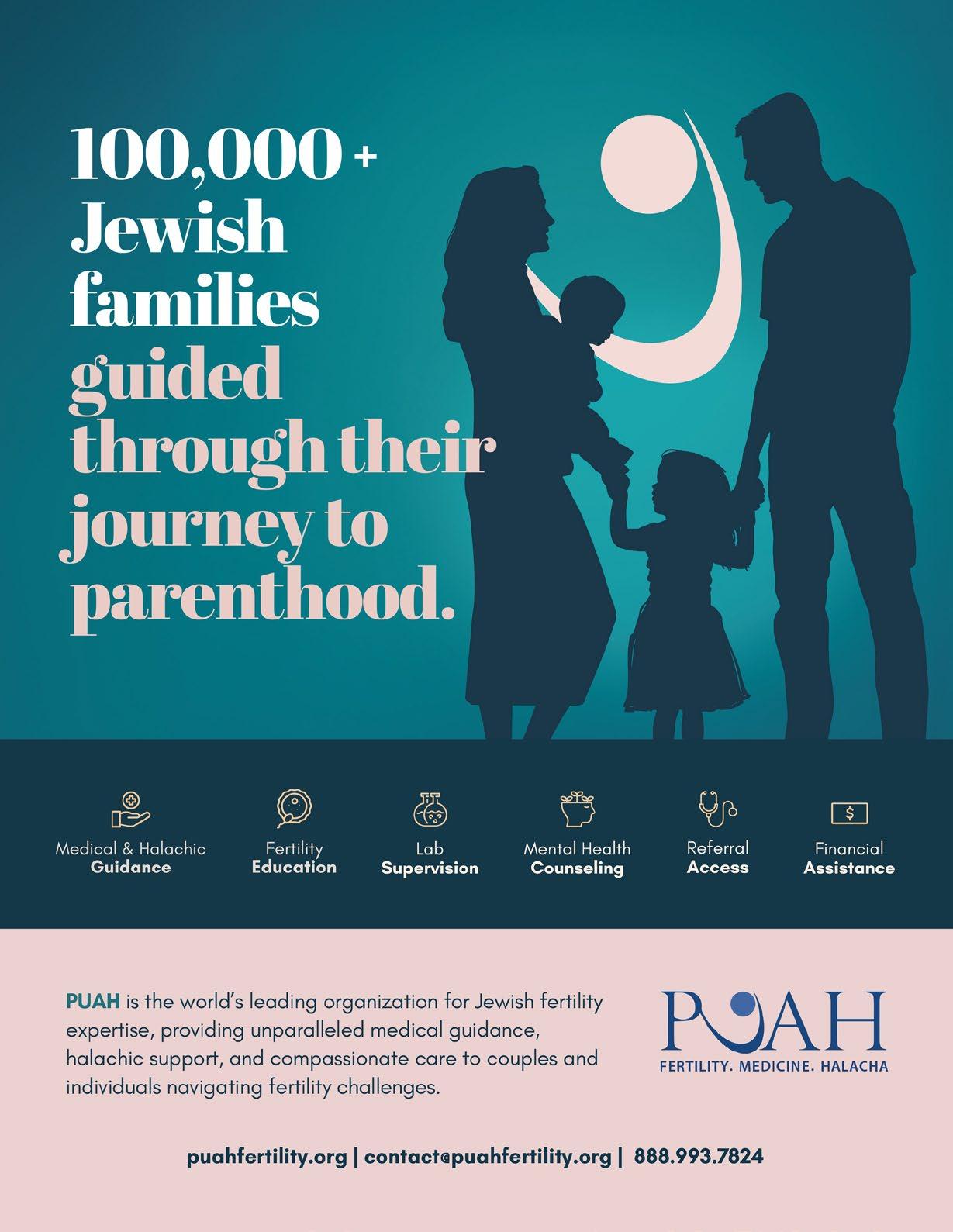
By Esther Sitbon for Lehaalot Magazine
Some women carry the past like a shadow. Others carry it like a torch.
Joelle Bohadana is one of those rare women whose very life is the meeting of both. Born to a father shaped by the aftermath of the Holocaust and a mother rooted in centuries-old Sephardic tradition, Joelle walks through the world as a living bridge of Jewish resilience and renewal.
In her role as Director of Awareness and Advancement for Puah, the international Jewish fertility organization, she now helps others navigate some of life’s deepest and most delicate journeys. But her own path — from secular pop culture to Torah, from Montreal to Yerushalayim, from the stage to the soul — is a story of transformation, light, and love.
In this heartfelt conversation, Joelle shares how her inner flame was reignited — and how she now helps others do the same.
Esther Sitbon: Joelle, it’s such a joy to have you with us. Let’s begin with our signature question: if your life were a book, what would its title be?
Joelle Bohadana: At first, I thought I’d call it From the Ashes. I kind of stole it — it’s the title of a book by the Chief Rabbi of Israel. But when I thought about it more deeply, I realized that doesn’t capture the whole picture. It’s not just about what I came
from — it’s about the strength that kept me going. So the title would be: The Will to Persevere.
Esther: I love that. You know, in the Sefirot, Netzach represents that very will — the divine drive to endure, to prevail. And yet the phrase From the Ashes also feels so true. Can you take us to the beginning of your story?
Joelle: It really starts with my parents. They come from two completely different worlds. I always say: I represent the entire Jewish people.
My mother is from Tétouan in Northern Morocco — what’s known as the Spanish zone. It’s very different from the south. The Jews there trace their roots directly back to the expulsion from Spain in 1492. They held on tightly to their JudeoSpanish identity. My mother specialized in JudeoSpanish song — songs passed from grandmother to mother since the time of the Inquisition. She was also a storyteller and a Spanish professor, so I grew up with this living, breathing sense of history and culture.
My father, on the other hand, came from Poland. He was born in 1946. His mother — my grandmother Zethel — came from a more traditional background. But my grandfather was very assimilated. My father grew up with zero Judaism — nothing. He didn’t even know what Yom Kippur was until he met my mother.
Esther: That contrast is incredible. On one side, a preserved flame going back five centuries. On the other, a fragile spark surviving the ashes of the Shoah.
Joelle: Exactly. My mother carried a torch. My father carried the remnants of a fire that had been nearly extinguished. But my mother brought him back to life in a way. She was mekarev him, she opened that door.
Esther: What kind of home did you grow up in?
Joelle: A home that evolved. At first, we drove to shul. We did the chagim, kept kosher in a classic Sephardic way. It wasn’t strict, but there was tradition. Then, my oldest brother Manny — who’s eleven years older than me — began his journey back to Torah. He was seventeen. I was six. Slowly, through his example, our home changed. He became my spiritual father in many ways. He studied in yeshiva, he would teach me little things, call me to share divrei Torah. Even though we had wide age gaps, his influence was constant.
Esther: And what about you? Were you always drawn to Judaism?
Joelle: Not at all. I was obsessed with theater. I did it for ten years. Acting was my dream. I was deep in pop culture — I wanted to move to Hollywood. I literally had a life-size poster of Leonardo DiCaprio in my room and I was convinced I was going to convert him and marry him. (laughs) But at the same time, I had my brother’s example. Twice a year I’d visit him and his growing family in Baltimore. When they came to visit, I’d cover my posters. I wasn’t ready yet. But something was seeping in.
Esther: That’s how the light begins — quietly. Was


there a turning point?
Joelle: Yes. When I was sixteen, I went on the March of the Living. It was the first time I saw the camps — Majdanek, the mountain of ashes. I remember standing there and thinking: If someone — if generations of people — have tried to wipe out this people, then we must be so important. There must be something here worth fighting for. That thought changed me. I realized: I’m Jewish. I matter.
Esther: And from there?
Joelle: When I was seventeen, I went to CÉGEP — Quebec’s pre-university program. It was the first time I found myself in a totally non-Jewish environment. I was studying liberal arts and communications in a very elite, left-leaning institution. And I realized something immediately: “I’m different.”
It wasn’t just the culture. It was the values, the way people were searching for truth in all the wrong places. I felt like I had something to bring. I said to myself: There’s something wrong about the way this society is functioning and how it determines its values. I have to bring my tradition and guide others, because people are very lost.
Esther: That’s such a powerful awakening. Did you feel the need to express it physically?
Joelle: Yes. For some women the journey is spiritual or emotional. But for me, I needed to make it visible. So… I put on a skirt.
“To manifest your difference,” I told myself. “To show that you were part of this important light.”
It felt like royalty. And coming from theater, I understood how a garment could transform you. Suddenly, I was being seen differently. Men treated me differently. Friends interacted with
me differently. There was dignity, a quiet power. Esther: That moment reminds me of Esther HaMalka — the moment she dons her royal garments and steps into her mission.
Joelle: Yes! That’s the moment she becomes Queen Esther. And I really felt that. That I was stepping into something holy.
Esther: You went to seminary in Israel too, right?
Joelle: Yes. A friend and I found a three-week trip to Israel. It was meant for women just starting their journey. I was already keeping Shabbat and kosher, so I wasn’t sure I’d be accepted. But I pushed my way in. That trip was the stamp to the envelope. I heard Torah taught with clarity, with truth, with intellectual depth. I’m very cerebral — I needed to know that Torah wasn’t just tradition. It was reality. It was truth with a capital T.
Esther: And when you returned?
Joelle: I went back to university — but I was changed. I asked my brother’s rabbi if I should stay in that environment. He said: “If she can be like a lion, she will survive. So I became a lion. I wore my long skirts. I asked my questions. I stood my ground. One of my friends told me, “You’re religious, but you were always cool.” I said, “Sorry, I’m not cool anymore.” (laughs) But inside I felt stronger than ever.
Esther Sitbon: Joelle, your path into observant Jewish life was unfolding beautifully. When did your personal story of building a home begin?
Joelle Bohadana: I was about 20 when I met my husband. He was actually the first boy I ever dated. I had already gone through such a spiritual transformation that I knew exactly what I wanted. He, on the other hand, was wearing jeans. (laughs) He was still growing in his own journey. So we dated for a short time and then paused. I told him I needed someone who was serious — who would commit to going to yeshiva. And that’s exactly what he did.
Esther: That shows such clarity — and strength. How did your families take it?
Joelle: My parents were supportive, though they asked a lot of questions. They’re very Yashar — honest, upright people. But I think my older brother really paved the way. He bore the weight of being the first to change. Thanks to him, the path was
already open.
We got engaged while he was in yeshiva, and I said: “We’re starting our marriage in Israel.” That was non-negotiable for me. He was learning, I wanted to build our home on Torah — and Eretz Yisrael was the foundation I wanted.
Esther: And that’s where you had your first child?
Joelle: Yes, our first child was born in Israel — and it was a miracle. At 23 weeks, my water broke. I didn’t even know I was in labor. I was alone, waiting for a taxi on Rechov Yaffo, leaning against a wall, trying to breathe. A stranger asked if I was okay, and I said yes — but I was in unbearable pain. When I got to the doctor, he told me:
“You’re in labor. But I want to prepare you… before 24 weeks, we don’t try to save the baby.”
I was in shock. My husband ran to the yeshiva and told the guys to daven. Then something remarkable happened — the labor stopped. I was hospitalized, put on strict bed rest, and two and a half weeks later, I started bleeding again. They did an emergency C-section at 26 weeks.
Esther: Baruch Hashem. How did you handle all of that emotionally?
Joelle: I just felt so grateful. My baby was born during Sefirat HaOmer, and everything was “Hafuch” — flipped upside down — but he was alive. He spent two and a half months in the hospital. His Brit Milah was on the day he was originally due — June 5.

Being in Eretz Yisrael made all the difference. The support, the tefillot, the way people just showed up with food and love… I was so moved. I remember saying: I don’t want to give birth in Canada. I want to give birth here. And that’s exactly what happened.
Esther: And now that miracle baby is twelve. And you have a large family, Baruch Hashem.
Joelle: Yes, thank God. After two years in Israel, we moved back to Montreal, and I went back to marketing work. Five children later, I still hadn’t found a job that truly matched my soul. Until Puah.
Esther: Tell us how you joined Puah. It feels like such a perfect fit for your journey.
Joelle: It really was hashgacha pratit. A neighbor and friend of mine — Morty Silver — called me one day in 2022. He said, “I have a client in the fertility world. Can I bounce some ideas off you?” We talked, and I gave him a few insights — how kallah teachers could be involved, things like that. And he said: “You really understand this — because you’re a woman. It’s a feminine domain.” At the time, Puah had outsourced its operations to a management company, and they were looking for a project manager. I took the position. I fell in love with the mission immediately. A few months later, I was offered the role I have now: Director of Awareness and Advancement.
Esther: For our readers who may not know, can you explain what Puah is?
Joelle: Of course. Puah is an international Jewish organization dedicated to halachic reproductive health. We guide people — women, couples, even singles — through fertility challenges, genetics, fertility preservation, and halachic guidance, all under the supervision of expert rabbanim. It started in Israel in the late 1970s as a response to the emergence of IVF. Rav Mordechai Eliyahu, the Sephardic Chief Rabbi of Israel at the time, saw that halachic clarity was urgently needed in this new frontier. Puah was born from that vision — and today, it operates in five countries: Israel, the US, Mexico, France, and Canada.
Esther: What is your role specifically?
Joelle: My role is to raise awareness — to bring the message of Puah to communities across North America and beyond. I speak at events, help coordinate educational programs, and develop strategies to share the vision and impact of the
organization. My goal is to make sure every Jewish woman knows that support exists — that she doesn’t have to walk through this alone.
Esther: Fertility struggles are so often silent. So many women suffer quietly.
Joelle: Yes, and that’s what makes it so important. This is a space filled with tears, with hopes, with very intimate battles. And often, women don’t even know what’s normal, what’s not. They don’t know how to ask for help — or who to turn to. Puah becomes that GPS. We walk with them — spiritually, halachically, medically, and emotionally.
Esther: It’s incredible to see how your own story — your resilience, your voice, your empathy — has led you to this sacred work. But you once mentioned to me that you feel called to do even more. That you have a desire to help Jewish women reconnect to their identity, their flame. Can you tell us about that dream?
Joelle: I feel it so deeply. I look around and see so many women who don’t know who they are. And not because they’re broken — but because the world doesn’t show them how radiant they truly are. I want to help women reconnect to their soul, to Torah, to their femininity — not in a way that demands, but that invites. I want to create spaces where Jewish women can learn, grow, and rise.
Esther: Joelle, I’m in awe of you. You’ve taken every thread of your life — your mixed heritage, your theatrical soul, your miraculous motherhood, your yearning for truth — and woven it into a light that uplifts others. I truly believe that the redemption comes in the merit of women like you. You are holding the torch — the same one lit by the women of the Inquisition, the women of Poland, the women of redemption.
Joelle: Thank you. It’s so special to be able to speak this out loud — to own it. To say: Yes, this is my story. I hope it inspires others to find theirs.
Esther: May Hashem bless you to continue elevating the light — in your home, your community, and across the Jewish world.
Joelle: Amen. Thank you for holding space for this conversation. It means so much to me.

Watch the full conversation here
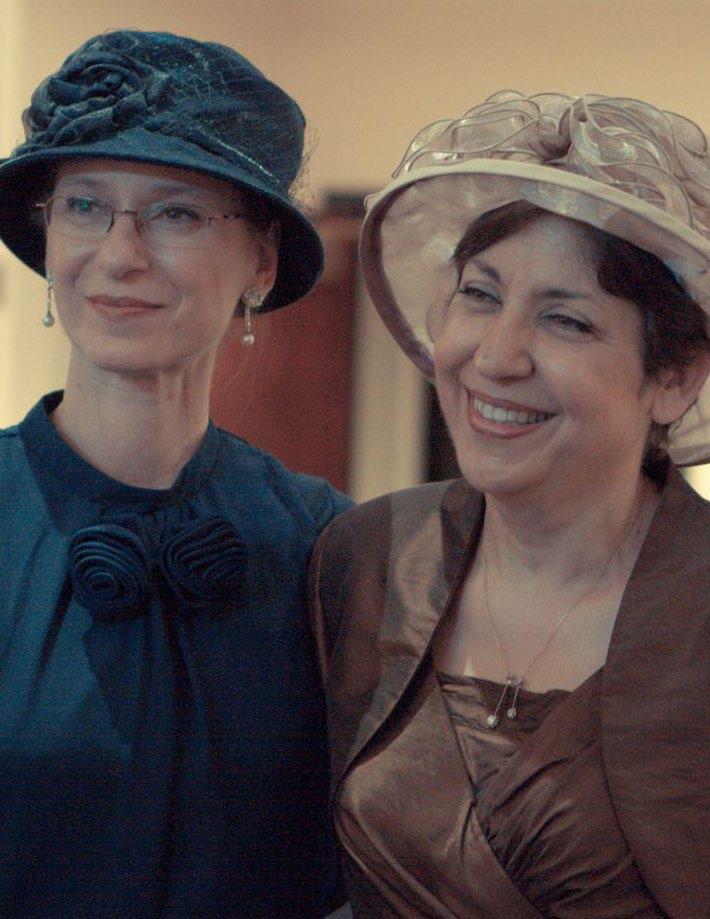





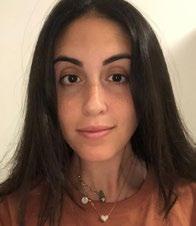

Sarin

Donna Adi Cover Art Internal Art: Illustration inspired by Donna Adi
Donna Adi is an artist and creative director known for her unique fusion of illustration and photography. With roots in fashion and visual storytelling, she’s collaborated with global brands like Balmain, Dior, Puma, Rayban, Nike, and Hugo Boss bringing a playful, bold touch to campaigns that stand out.
For over a decade, Donna has created visuals that blend narrative, emotion, and style. Her work has appeared in Vogue, Forbes, and Harper’s Bazaar, and has been shared by icons like Hailey Bieber, Gigi Hadid, Sofia Vergara, and Kourtney Kardashian.
Now, she’s turning the page trading her pixels for paint and exploring a new chapter in fine art. Inspired by a deep desire to create lasting art, Donna’s latest pieces blend fashion, nostalgia, and color in a way inviting you to slow down, look closer, and actually feel something.

